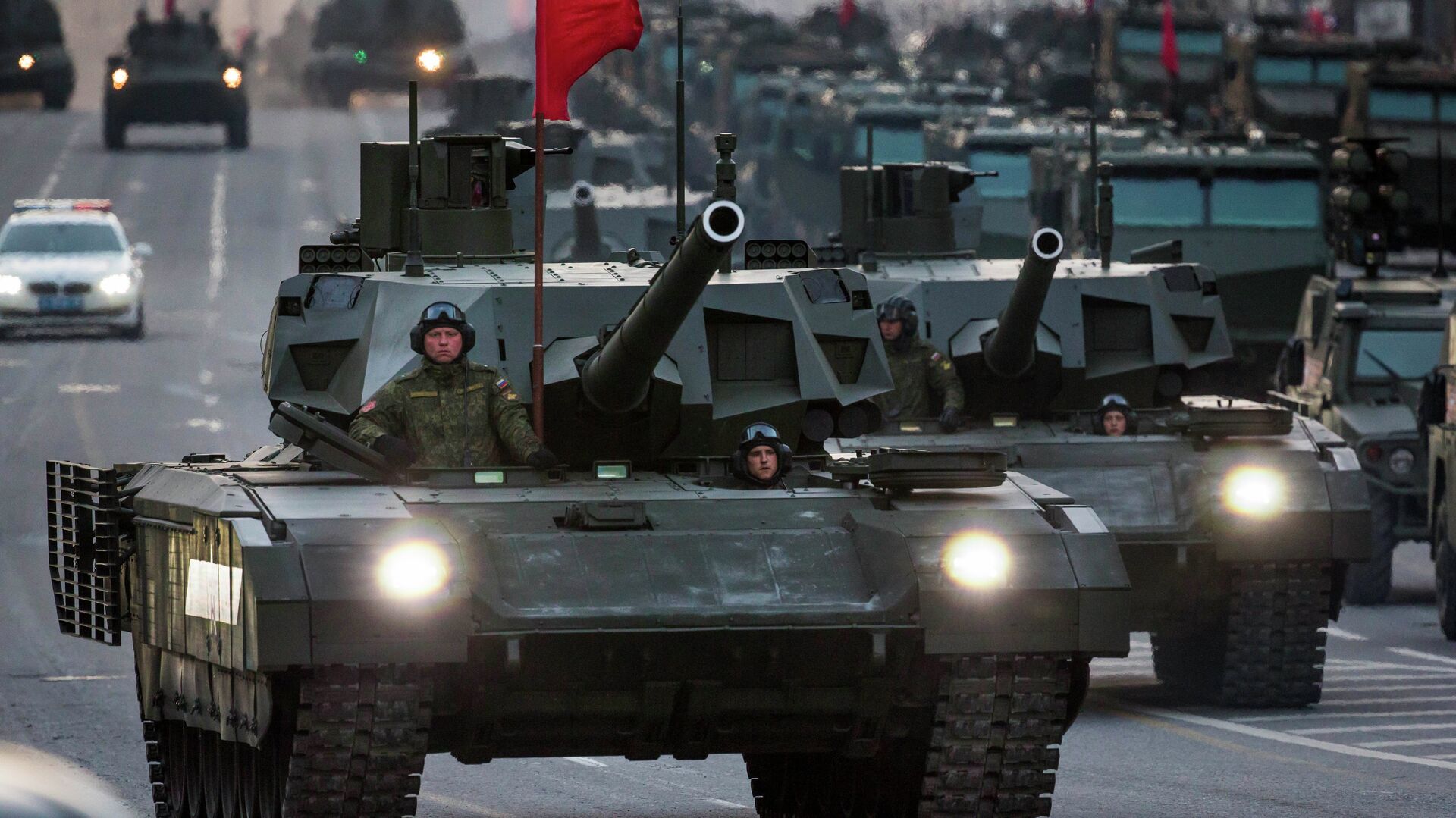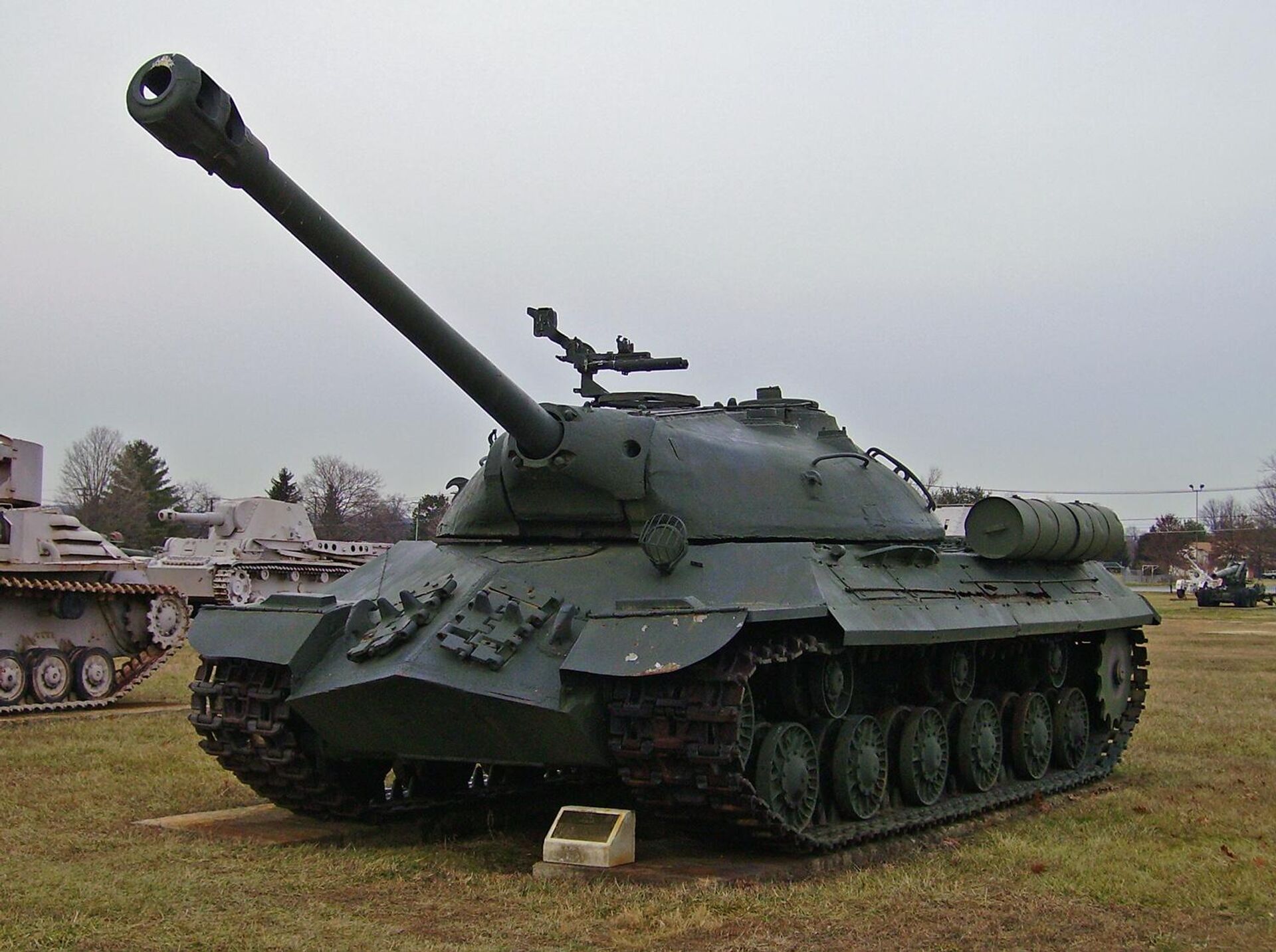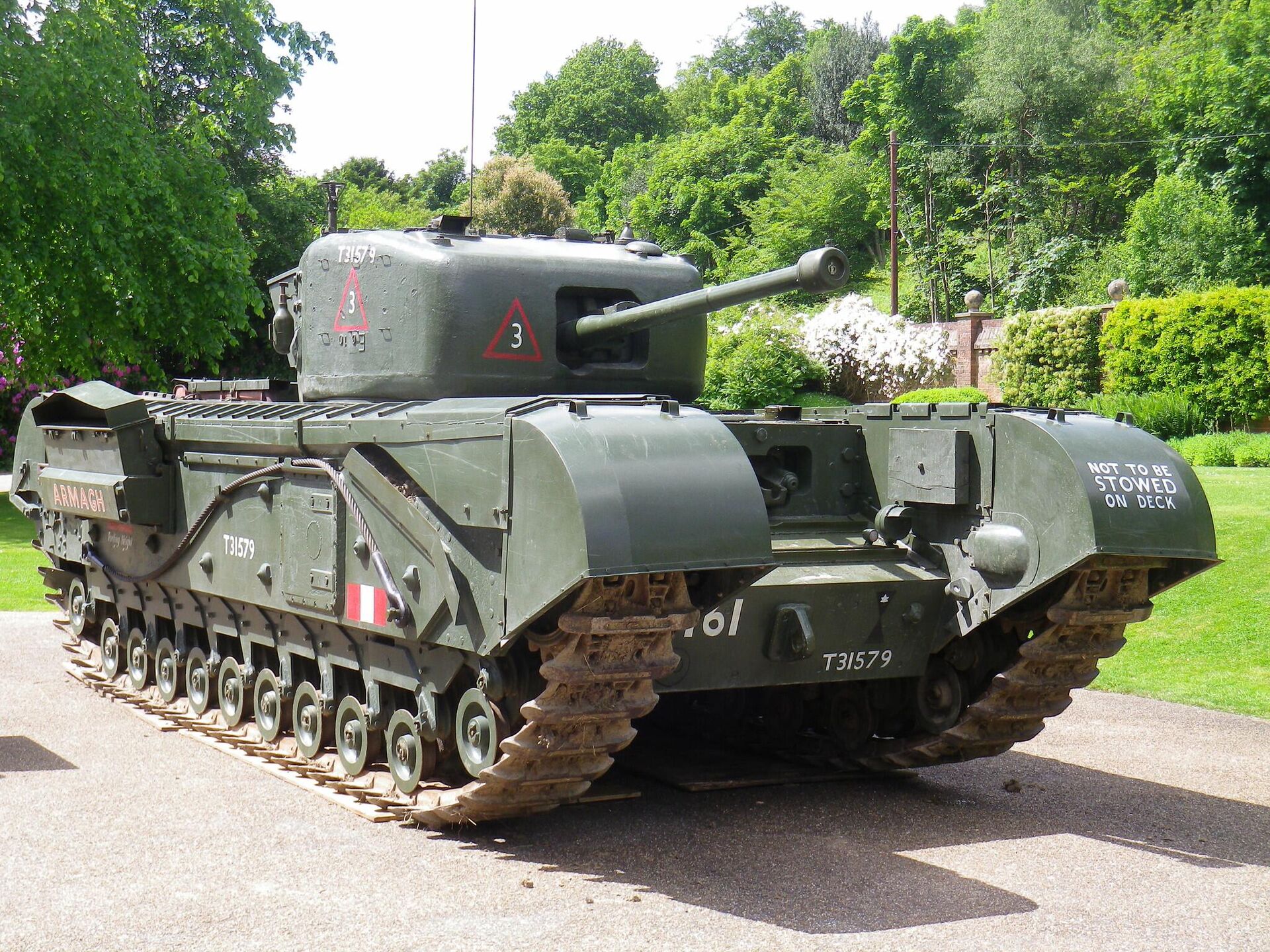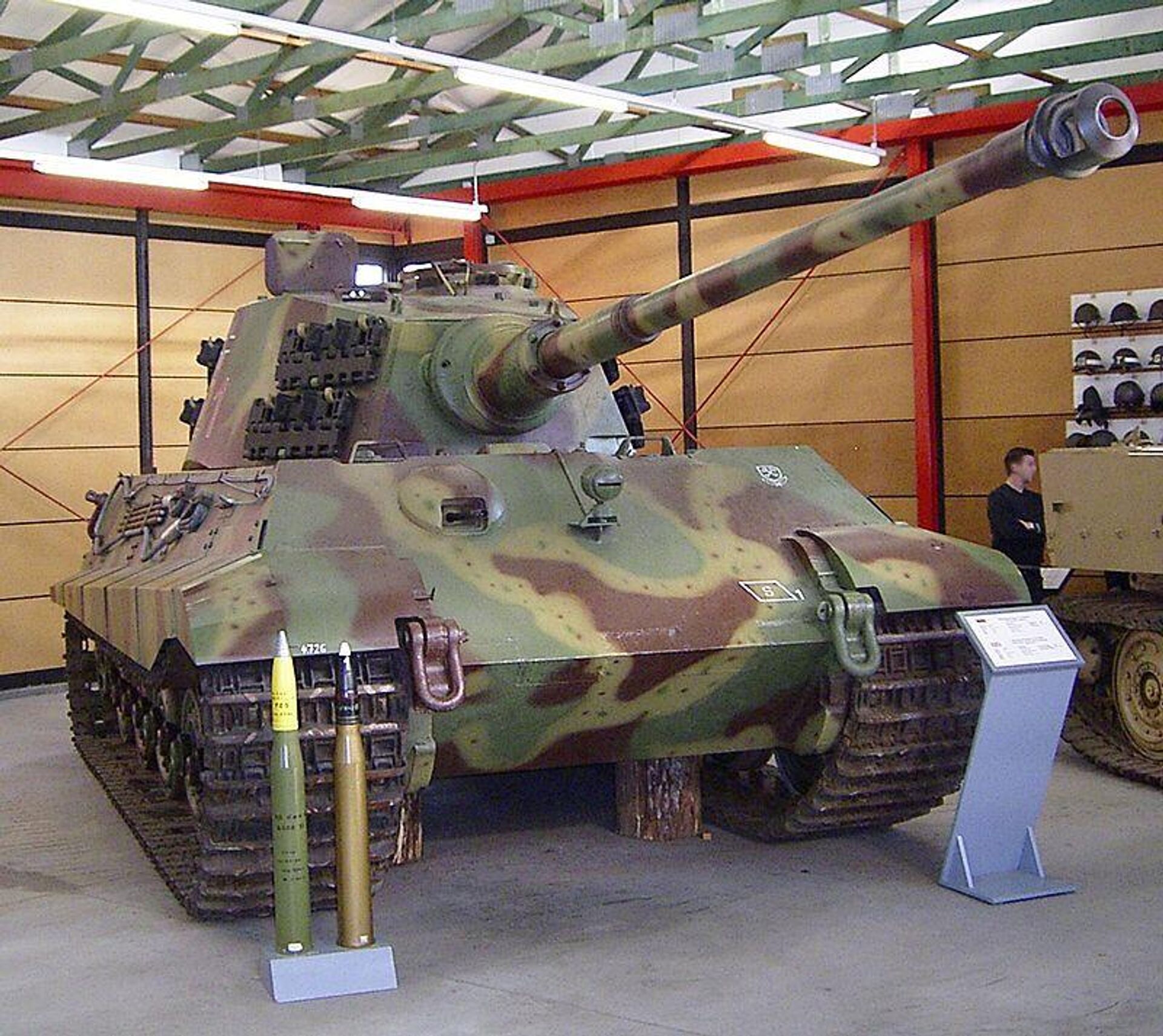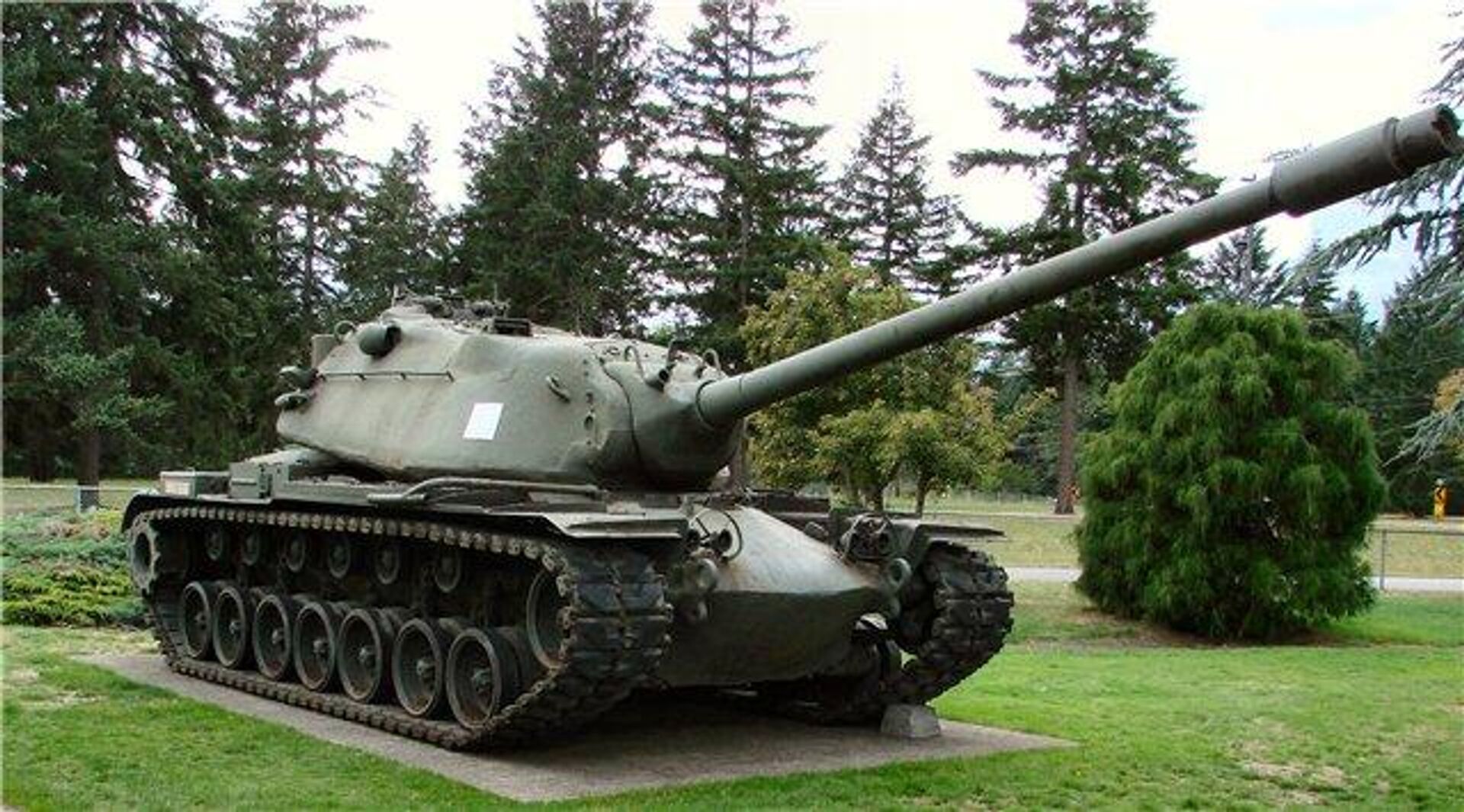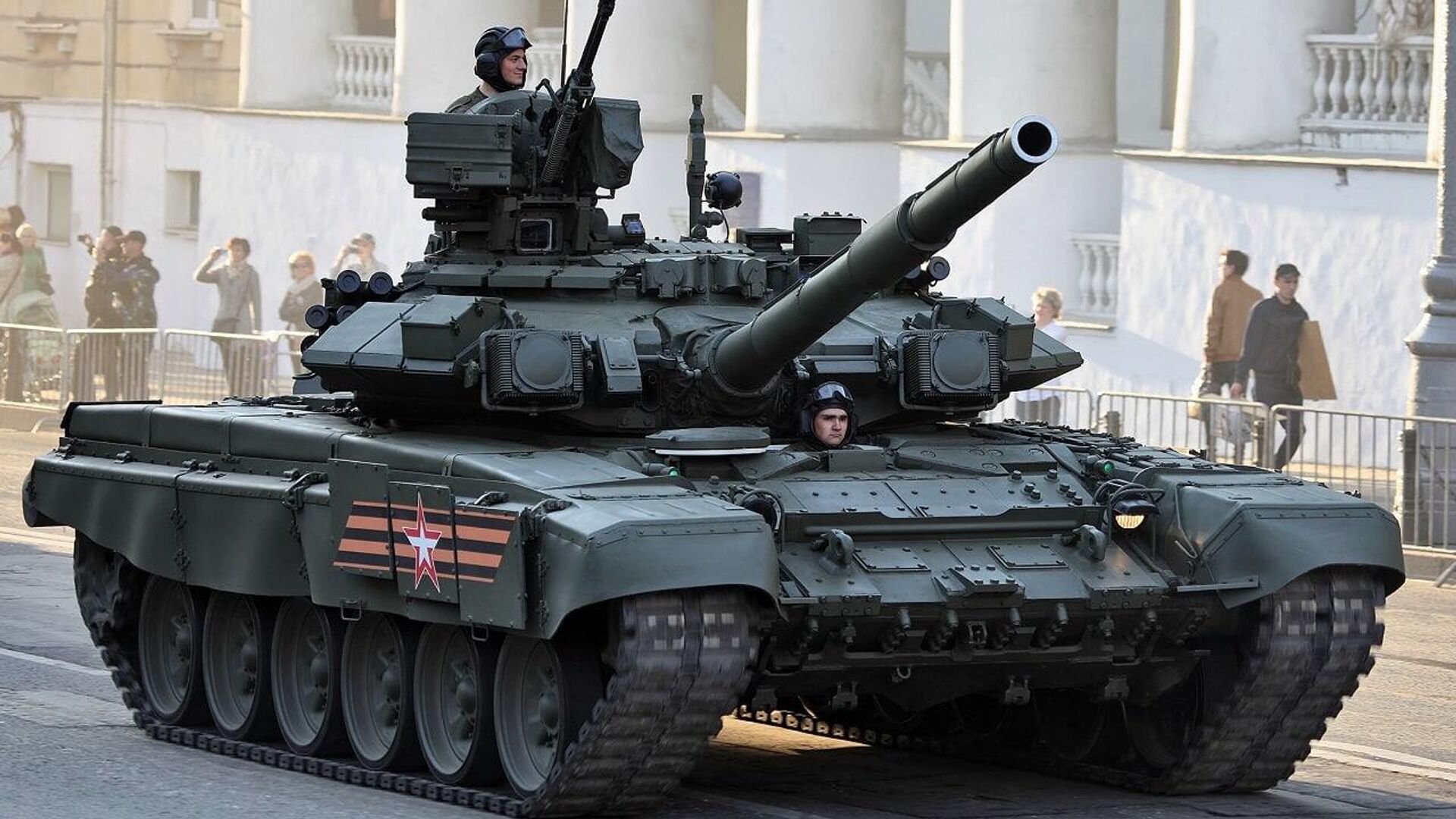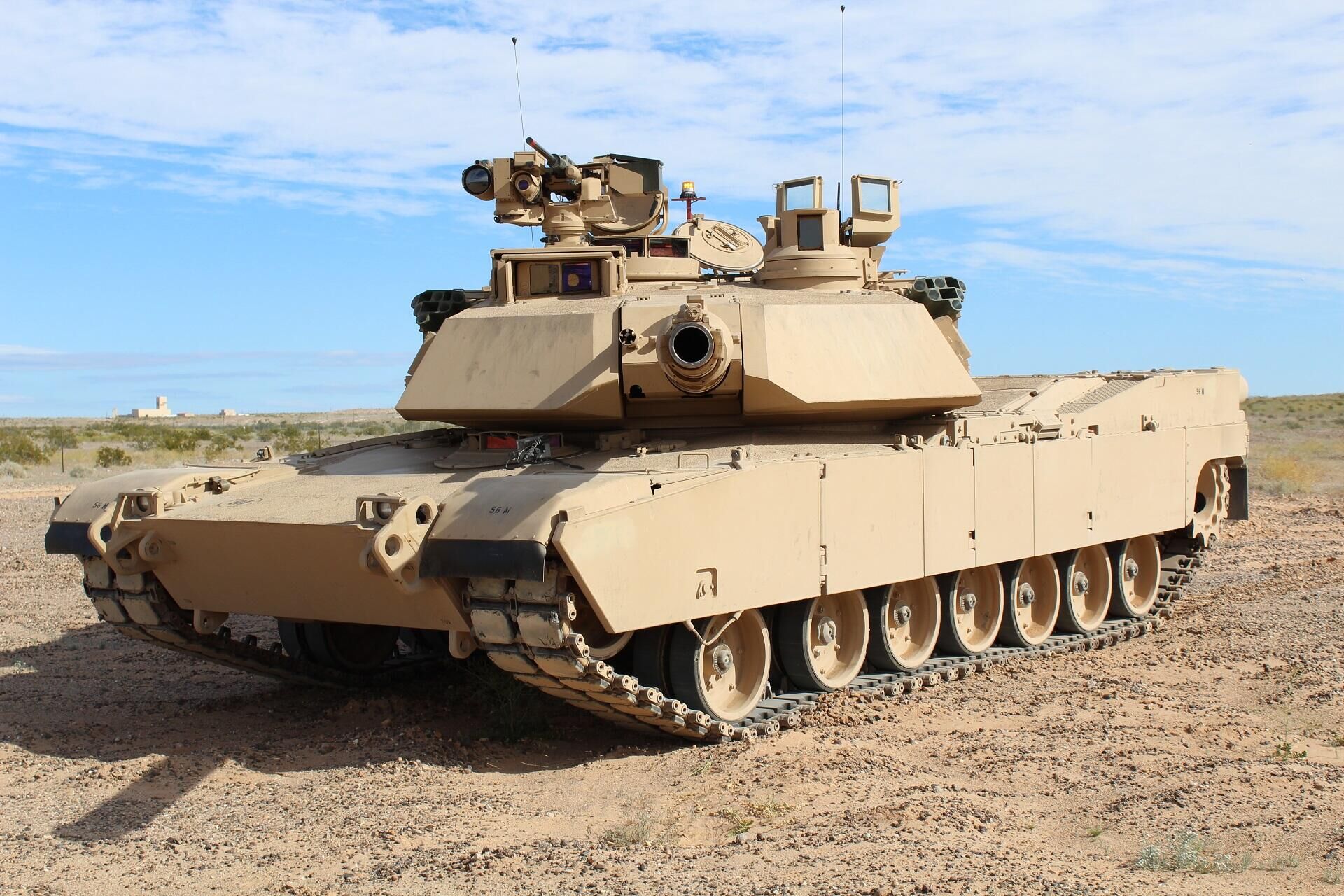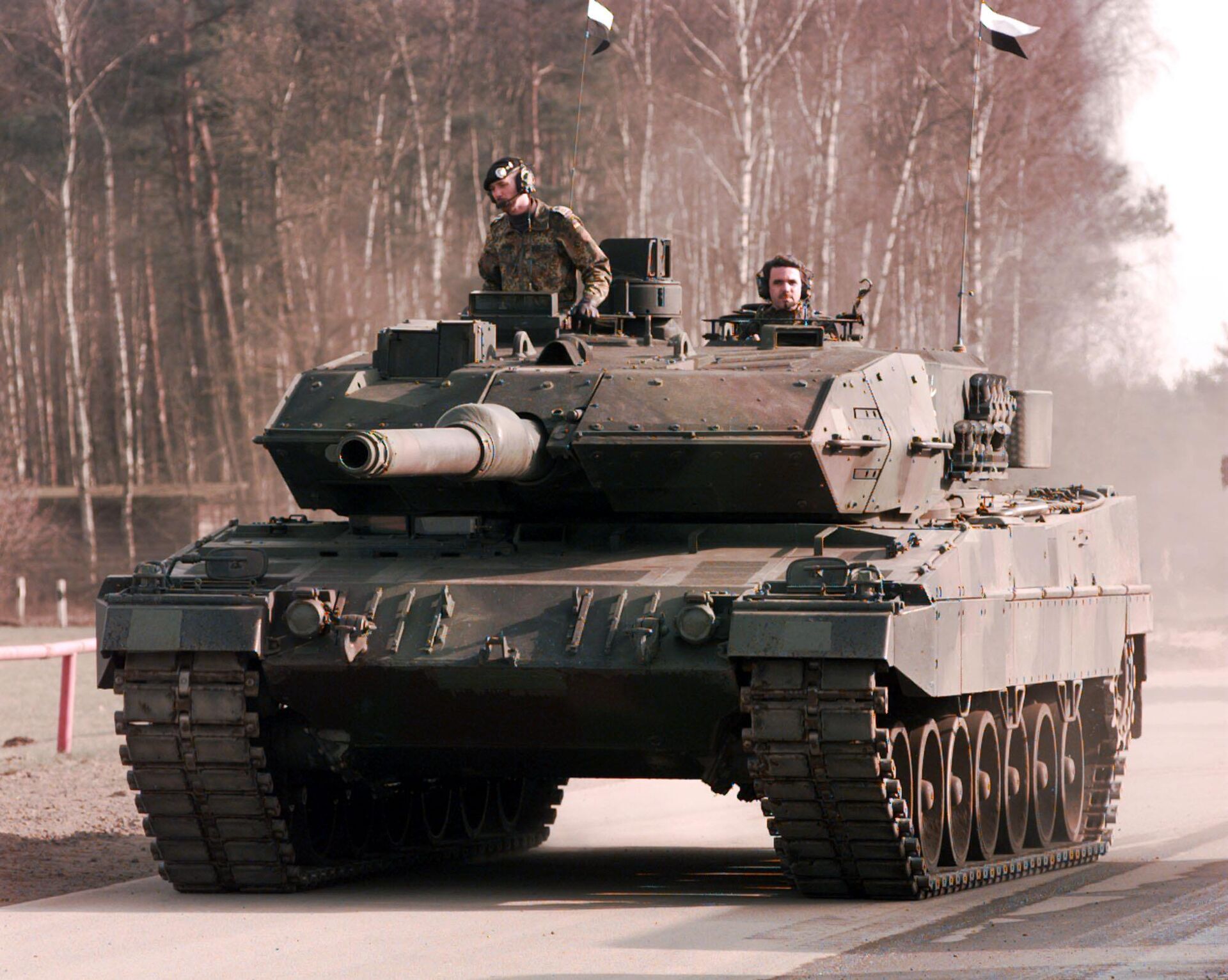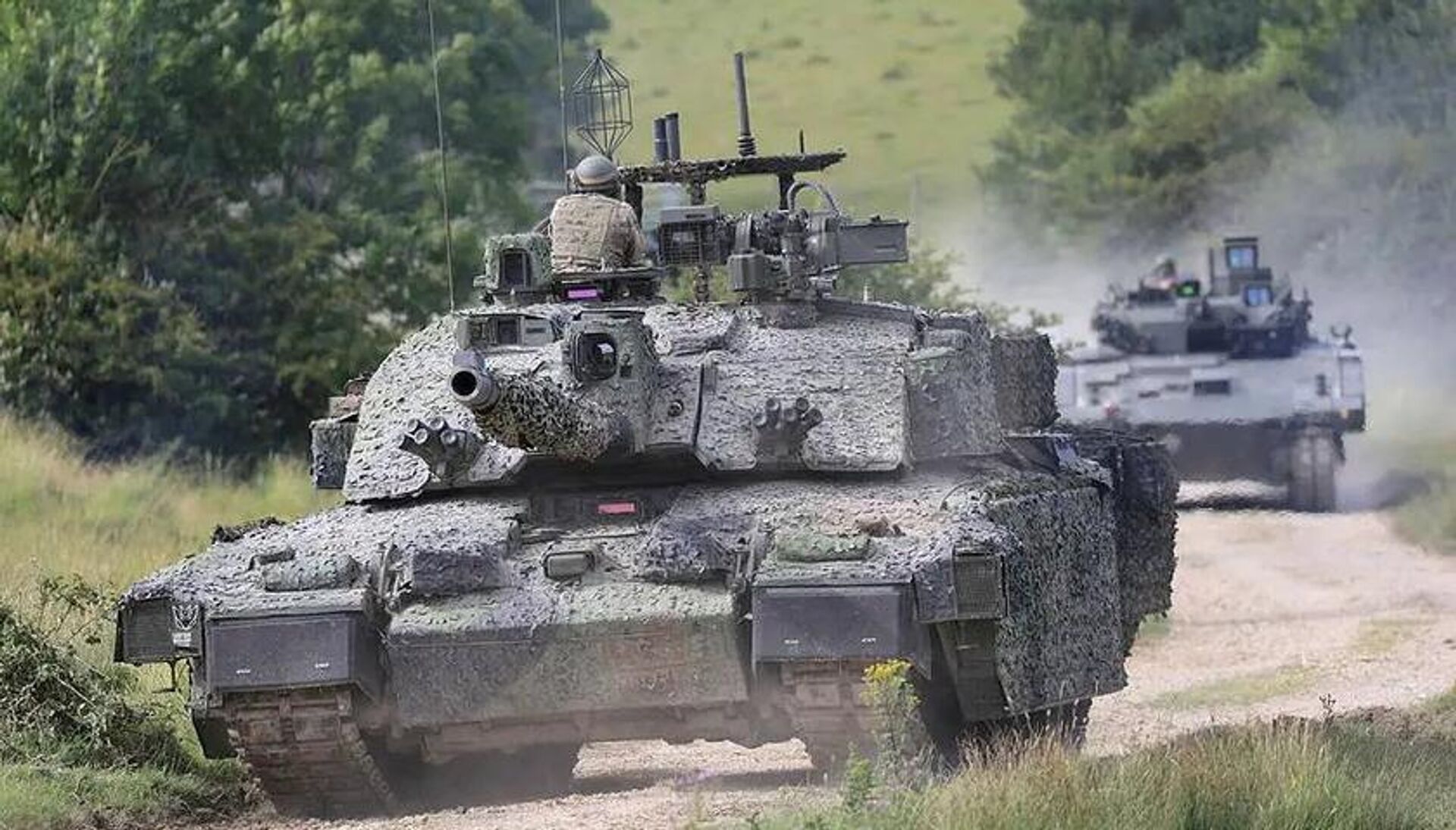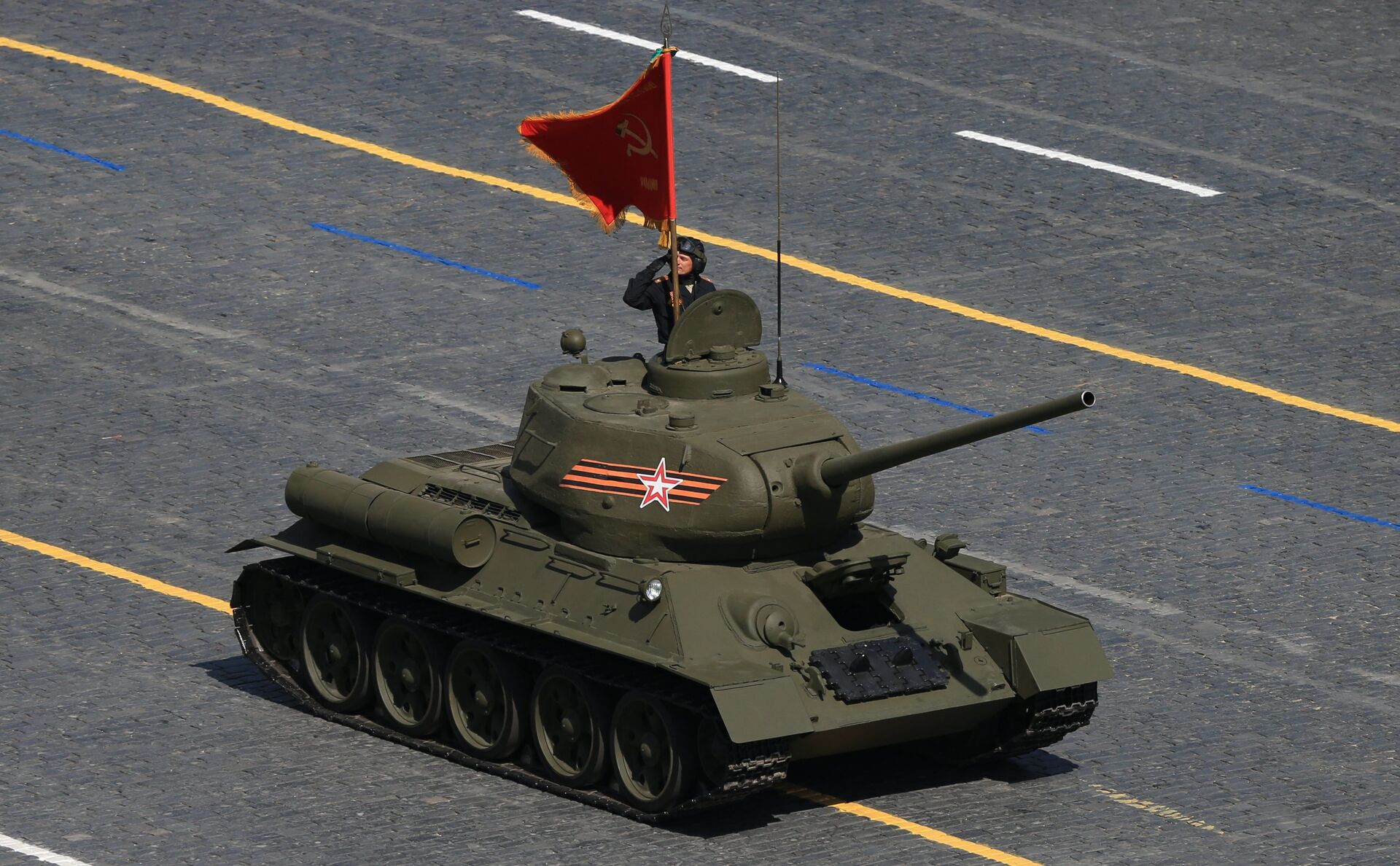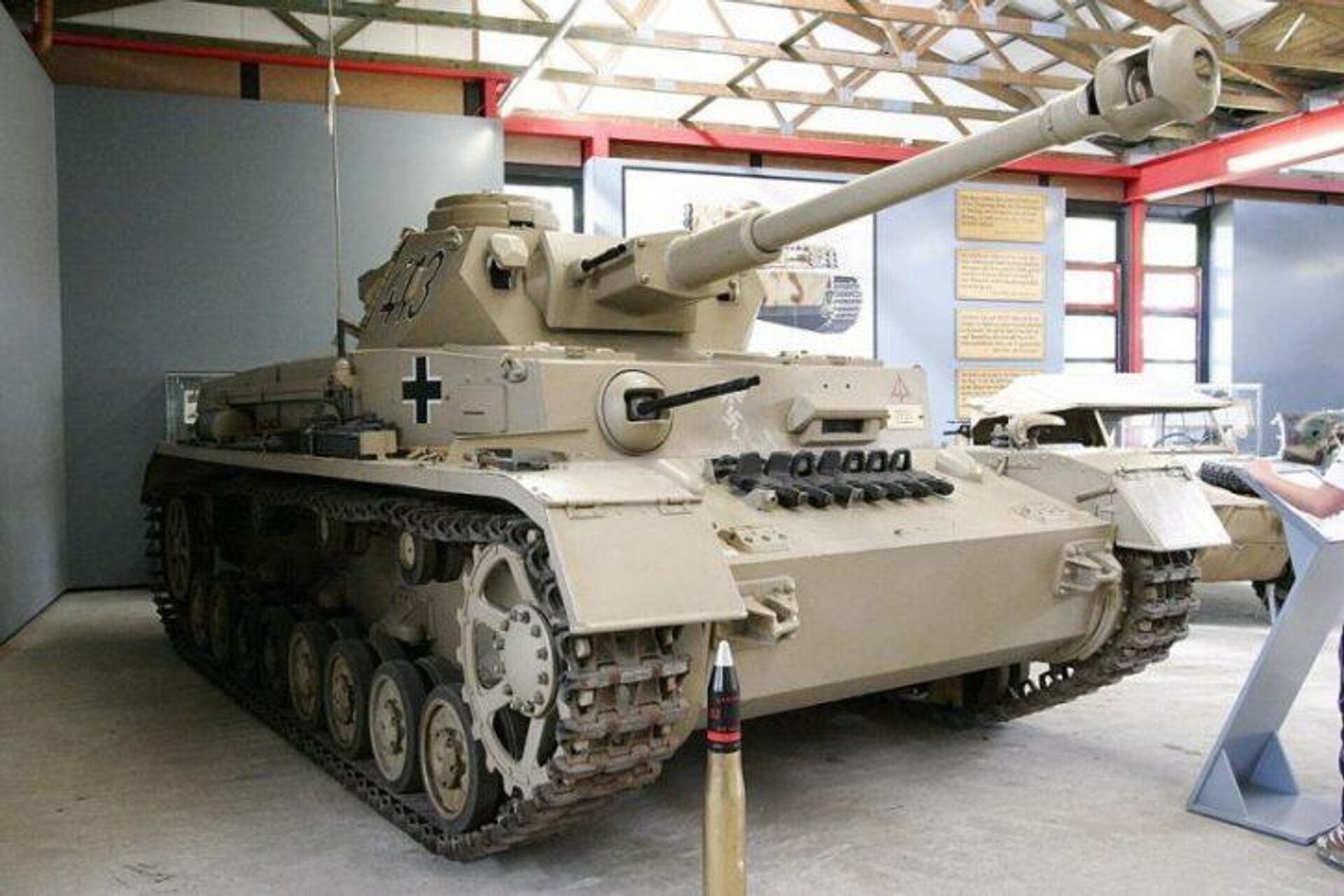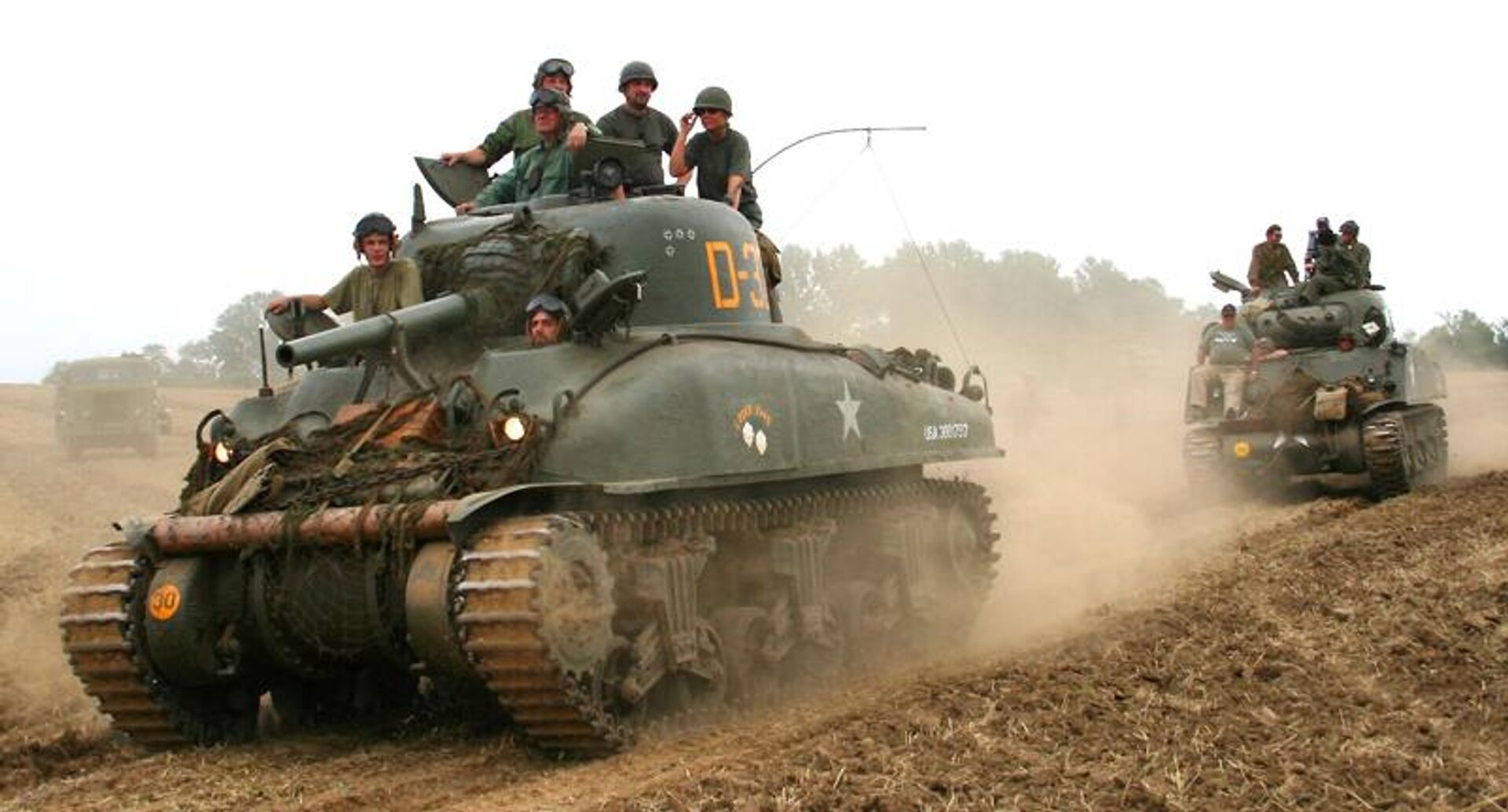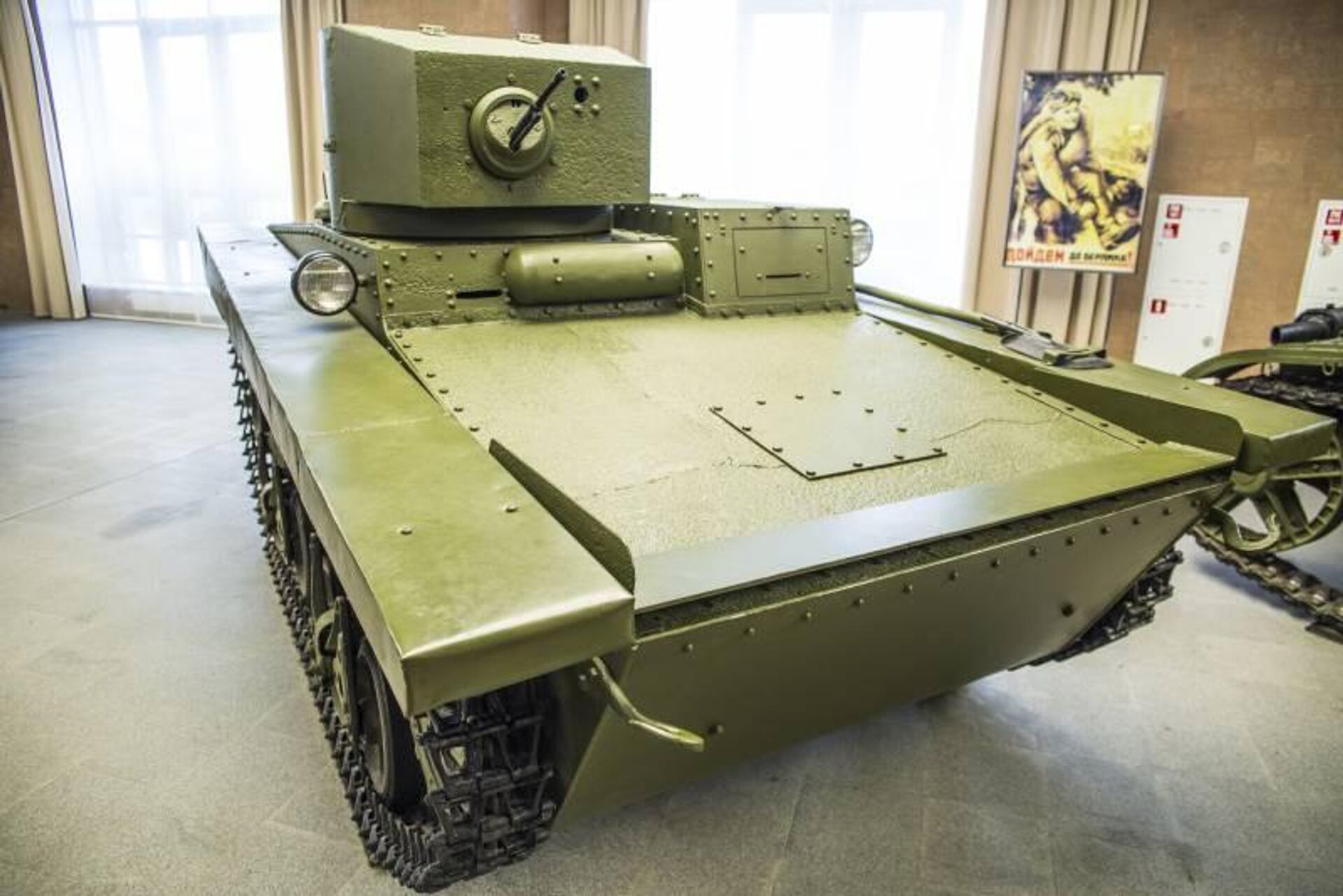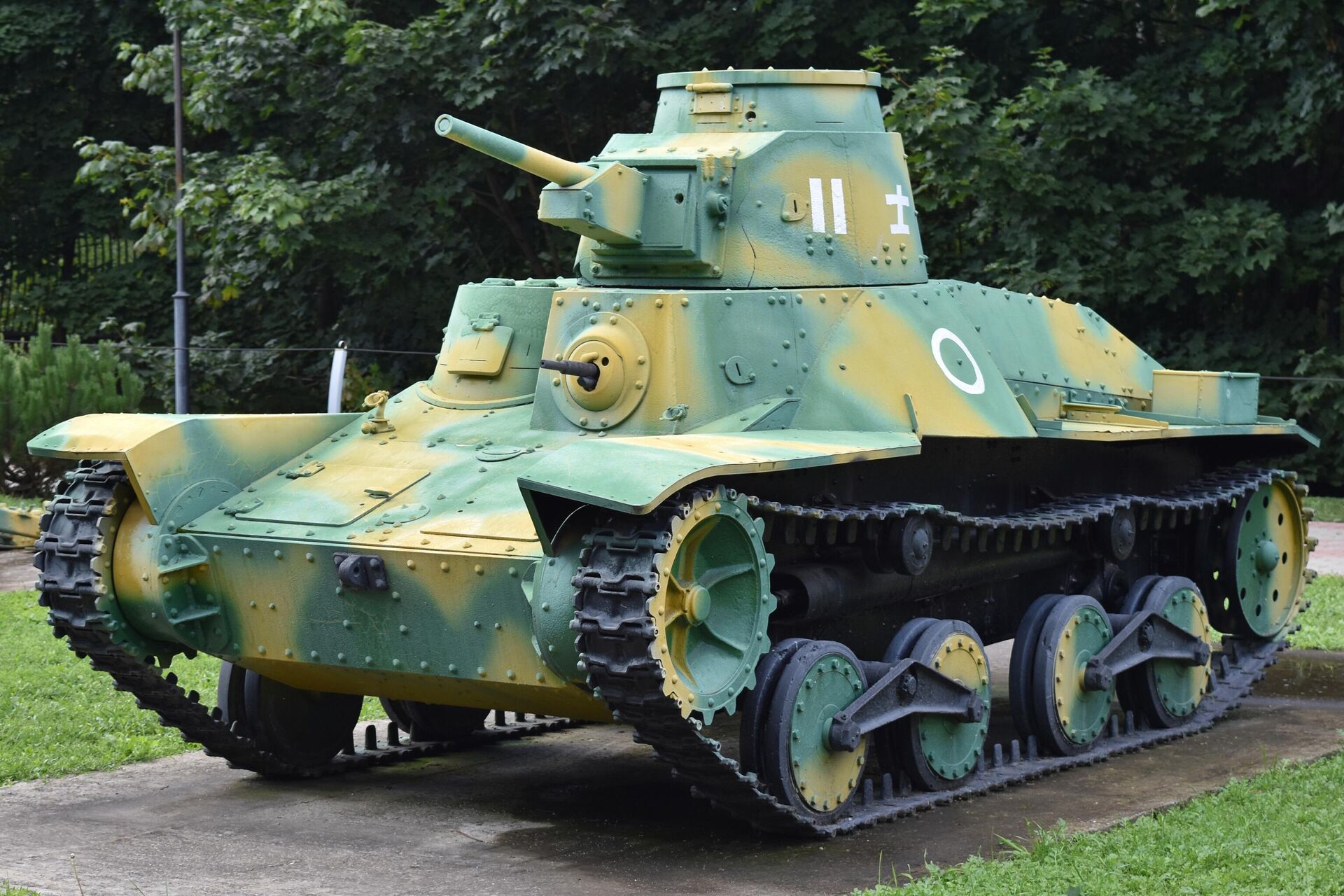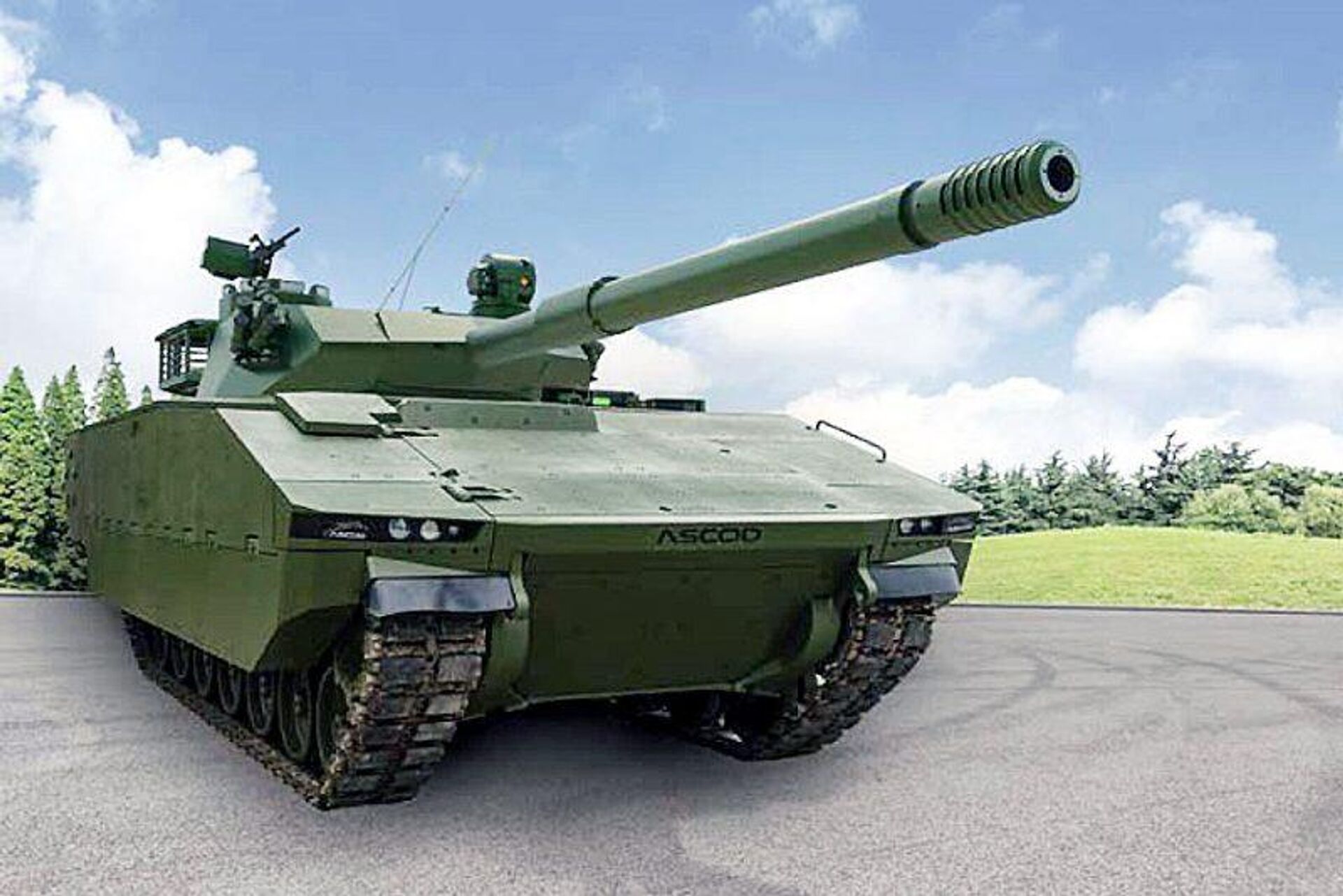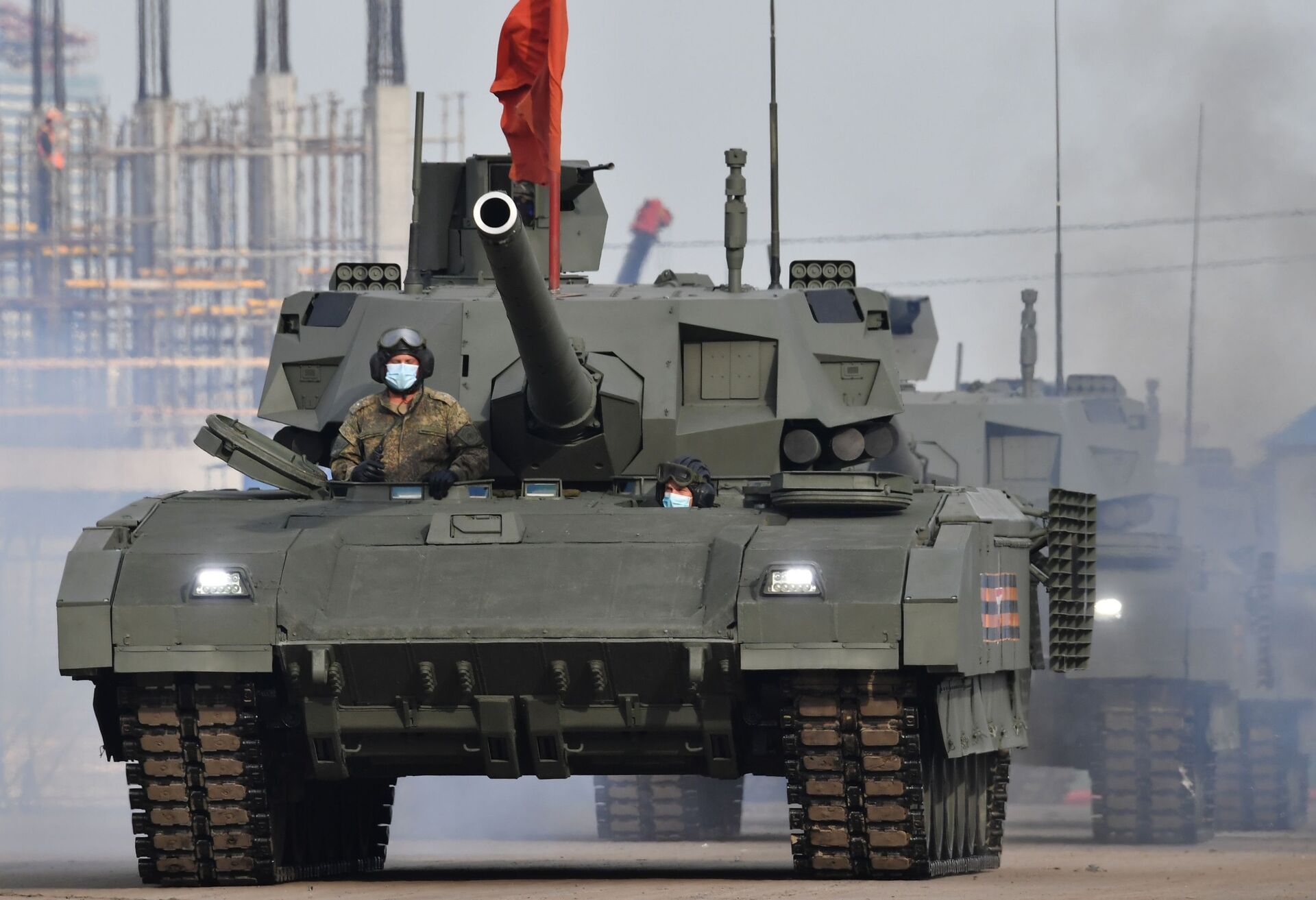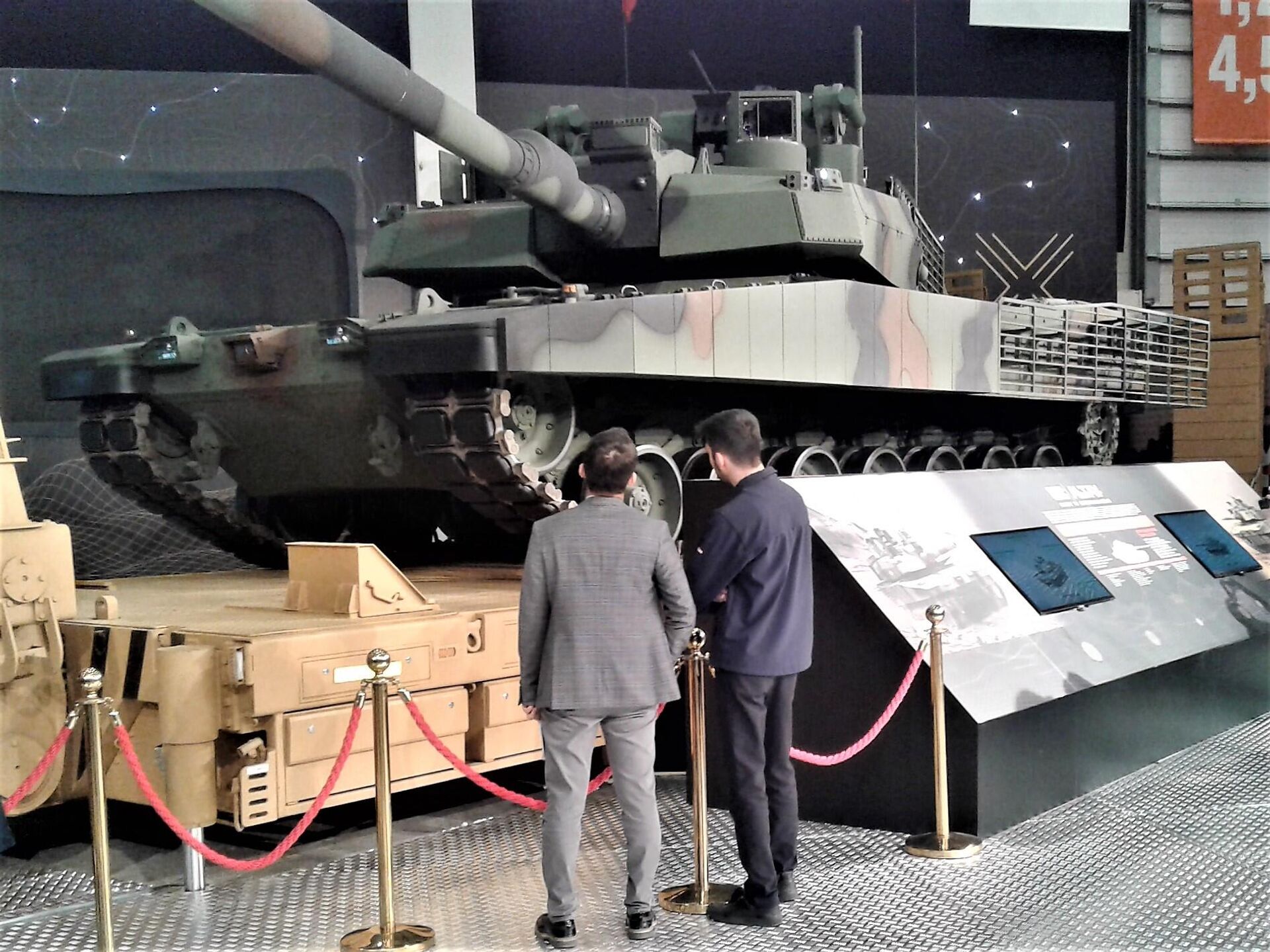https://sputnikglobe.com/20231006/which-tank-is-the-fastest-1113877349.html
Which Tank is the Fastest?
Which Tank is the Fastest?
Sputnik International
Amidst a fervent race for tank supremacy, battle tanks have evolved significantly on the battlefield, thanks to the moderm warfare dynamics, increased budgets and the progress in military research and development driving technological advances. This piece unveils the unrivaled speedster in combat: the metal beast defying limits.
2023-10-06T13:59+0000
2023-10-06T13:59+0000
2023-10-06T13:59+0000
sputnik explains
sputnik
russia
germany
world
wikipedia
shtora
t-64
t-14 armata
https://cdn1.img.sputnikglobe.com/img/102329/82/1023298270_0:290:5570:3423_1920x0_80_0_0_7e35a2466d852b5ea90fc09555b92e82.jpg
Tanks, equipped with heavy armor, are a staple of ground-based military operations. Their role is vital in shaping the outcome of warfare, offering a powerful combination of maneuverability, defense, and firepower. Tanks are essential for breaching fortified enemy positions, supporting infantry, and neutralizing armored threats. This establishes them as a fundamental tool for ground forces.A tank's speed is more than a mere badge of honor for military engineers; it directly influences its agility in adapting to dynamic battlefield scenarios. Swift deployment and mobility are crucial for effective flanking, fortification, and strategic withdrawals. Moreover, speed is vital for survival, enabling tanks to evade enemy fire and secure advantageous positions. This impetus provided by speed is pivotal to a tank's effectiveness, allowing it to maneuver swiftly across diverse terrains, potentially determining the difference between gaining a tactical edge or becoming vulnerable. Throughout military history, the pursuit of speed in tank design has been unrelenting, driven by the ever-changing demands of modern warfare.Sputnik demystifies battle tanks by singling out the fastest ones and understanding the nuances of their speed. This involves comprehensively examining factors and scrutinizing significant contemporary tanks known for their remarkable speed. Through this exploration, we aim to identify the fastest tank and grasp how this trait influences military outcomes.Overview of Different Tanks and Their Roles in WarfareTanks, the backbone of ground-based armored warfare, come in various classes, each tailored for specific combat roles. Heavy TanksHeavy tanks are a category of armored vehicles designed with an emphasis on maximum firepower and robust armor protection. They are characterized by their substantial weight, which can often exceed 60 tons, making them formidable behemoths on the battlefield. The primary purpose of heavy tanks is to engage in head-on confrontations with enemy forces, acting as spearheads in offensive operations and as impervious defensive bulwarks.These tanks are engineered to withstand heavy enemy fire, making them ideal for breaching fortified positions or leading assaults against heavily defended areas. Due to their immense weight and powerful armaments, heavy tanks are often tasked with breaking through enemy lines, allowing lighter and more mobile units to exploit the breaches and carry out flanking maneuvers.Their weight provides them with increased protection, but can reduce their mobility and maneuverability. Other characteristics of heavy tanks include:ArmorArmamentEngine & PropulsionCrew size Fuel tankOperational RangeNeed for Logistical SupportEvolution of Heavy Tanks in Military HistoryThe inception of heavy tanks in warfare traces back to their early development during the stormy days of World War I. This period was marked by ingenuity and experimentation in armored combat strategies.As World War I unfolded, the emergence of tanks came in direct response to the problematic issues posed by trench warfare. Efforts by nations like Britain, France, and Germany paved the way for the advent of these mechanized marvels. The early iterations, such as the British Mark series and the French Schneider CA1, bore the distinctive features of pace, armor, and a weaponry mix comprising machine guns and modest-caliber artillery. Their primary mission was to pierce deeply entrenched enemy lines. However, they encountered engineering hitches, like mechanical reliability concerns and constrained speed. Nonetheless, they demonstrated the transformative potential of armored vehicles in breaching impregnable positions.During the interwar interlude, a surge of innovation swept through tank design and technology. Engineers were profoundly enthralled by refining mobility, firepower, and armor integrity. It was during this period that the conceptual framework of heavy tanks materialized. Distinguished by their substantial heft, terrific armor cladding, and tough armaments, heavy tanks were envisaged as vanguards of assaults, breakthrough units against enemy lines, and bastions of resilience against concentrated fire.The crucible of World War II heralded the widespread deployment of heavy tanks, particularly by key players like the Soviet Union, Germany, and, to a lesser extent, the US and United Kingdom. The Soviet Union unveiled heavy tanks like the IS-2 and IS-3, engineered to engage heavily fortified strongholds. Germany, in turn, introduced heavy tanks like the Tiger I and Tiger II (King Tiger), characterized by their heavily fortified armor and the firepower prowess of their 88 mm guns. The Allied forces fielded heavy tanks, with a preference for more balanced designs such as the British Churchill and the American M26 Pershing, which skillfully blended firepower, protection, and mobility. In the Pacific theater, the US adroitly employed tanks like the M4 Sherman, bolstered by additional armor, aptly christened the Jumbo Sherman to surmount heavily entrenched Japanese positions.The aftermath of World War II unraveled the constraints of heavy tanks. Evolving anti-tank weaponry and shifts in military doctrines laid the groundwork for the ascendance of main battle tanks (MBTs). These heralded a new era, amalgamating the soundness of heavy tanks with a newfound agility and adaptability. This fundamental transition adjusted the interplay in armored warfare. While heavy tanks have receded amidst historical accounts, their legacy endures in the blueprint of contemporary armored vehicles. Tenets like robust armor plating and formidable main artillery find a seamless integration into the modern armory.Notable examples of heavy tanks with major technical specification are as follows:Sources: Wikipedia, Tanks-encyclopedia.comSources: Wikipedia, Tanks-encyclopedia.comSources: Wikipedia, Tanks-encyclopedia.comSource: WikipediaMain Battle Tank or Battle TankAt the forefront of armored warfare, battle tanks (also main battle tanks) embody the zenith of technological prowess. These multirole armored vehicles are conscientiously built to thrive in diverse battlefield scenarios, deftly striking a balance between offensive striking power, agility, and protection. This equilibrium renders them highly proficient in engaging enemy armor and infantry, underscoring their indispensability in modern armored warfare.These military machines represent the height of armored warfare, blending offensive power, agility, and defense for versatile performance on the battlefield. They excel in engaging enemy armor and infantry, making them crucial in modern warfare. The 1960s and 1970s marked a significant shift as battle tanks took precedence, leading to the decline of other tank types and specialized armored vehicles.During the 1960s, the military sphere witnessed a shift driven by the relentless pursuit of technological superiority in warfare. As advancements in anti-tank ammunition surged, so did the demand for avant-garde armor solutions. One pivotal milestone emerged in the form of the Soviet T-64 tank, a precursor of innovation that introduced composite armor into the global military lexicon. This novel development encompassed a sophisticated blend of reinforced glass, steel, and textolite, ushering in a new era of protection against formidable adversaries in the ever-evolving theater of war, including high-explosive anti-tank rounds and armor-piercing shells.Conceived at the esteemed Royal Ordnance Factories, the British Chobham armor represented a watershed moment in defensive technology by ingeniously combining ceramics with diverse other materials, effectively neutralizing the destructive potential of high-explosive anti-tank munitions.The advent of military helicopters posed a fresh conundrum in the dynamic landscape of combat operations. Before their widespread deployment, armored vehicles were meticulously crafted with a primary focus on frontal defense. However, the advent of military helicopters necessitated a turning point in tank design philosophy. This entailed the installation of shields encompassing all sides, offering comprehensive protection against potential threats. Additionally, this strategic adjustment sought to shield occupants from possible radiation exposure, further underscoring the need for a holistic defensive overhaul. Initially, main battle tanks relied on formidable steel armor to mitigate a spectrum of risks. Nevertheless, as the challenges escalated in sophistication, it became evident that a fundamental transformation in defense mechanisms was imperative to counter these evolving risks effectively.Warfare technology advanced in the 1980s with the advent of explosive reactive armor (ERA), a novel invention spearheaded by Israel. This transformative system is a formidable bulwark against modern anti-tank weaponry and armor-piercing shells, heralding a new era in battle tank security. The versatility of ERA lies in its swift relevance to tanks, instantly bolstering their resilience on the battlefield.However, activating ERA blocks introduces a crucial consideration: potential risks to nearby ground troops. Despite this concern, ERA has firmly entrenched itself as a pivotal feature in the arsenal of many Russian battle tanks, particularly in its Kontakt-5 iteration. This advancement has proven instrumental in effectively countering high-explosive anti-tank (HEAT) rounds and kinetic projectiles, underscoring its enduring relevance in modern warfare.Active protection systems (APS) have also emerged as a critical invention, initially conceived by the Soviets. These systems are engineered to thwart threats well before they reach their intended target – the tank. Noteworthy iterations like the Arena and Shtora systems have garnered widespread recognition for their efficacy in safeguarding armored assets. Discussions within military circles underscore the formidable capabilities of Russia's latest marvel, the T-14 Armata tank, spotlighting its Afghanit Active Protection System, seamlessly integrated with an advanced AESA radar. This integration empowers the T-14 Armata to intercept a broad spectrum of airborne threats, from missiles to potential aerial adversaries.The United States has embraced analogous technologies, exemplified by including the Missile Countermeasure Device (MCD) within the Tank Urban Survival Kit (TUSK) deployed alongside the M1 Abrams tanks during military operations in Iraq. At the core of an MBT's offensive might lies its main gun, ingeniously integrated into the turret. This strategic placement allows for swift and precise targeting, a pivotal aspect in the heat of battle. The loading and firing mechanisms are meticulously designed, ensuring seamless operation even in the most demanding combat situations.The contemporary MBT is an engineering marvel, boasting advanced fire-control systems that unprecedentedly elevate its combat prowess. This sophisticated suite includes cutting-edge range finders, automated controls, and stabilizers. These components guarantee pinpoint accuracy, even amidst tank movement or external vibrations.The integration of such advanced fire-control systems not only fortifies the tank's offensive capabilities, but also empowers its crew. The tank's gunnery team gains unprecedented control and precision when engaging targets, ensuring every shot counts. This technological leap has redefined the dynamics of armored warfare, providing crews with a distinct advantage on the battlefield.The dual-purpose main gun is the linchpin of a battle tank’s adaptability. This capability means that a single tank can swiftly transition from engaging heavily armored adversaries to addressing infantry or enemy vehicles. Such versatility ensures that MBTs remain a formidable force across an array of combat scenarios.Modern battle tanks are typically part of armored units, often accompanied by infantry in specialized fighting vehicles. Surveillance resources and ground-attack aircraft also support them. Like their predecessors, these tanks use continuous tracks for mobility, allowing them to navigate rugged terrain like sand and mud. This track system also enables them to overcome various obstacles.Tanks are designed to be watertight, allowing them to submerge in shallow waters with a snorkel. While tracks provide stability, tanks are generally slower than wheeled vehicles, with a top speed of around 65 kilometers per hour (40 miles per hour). The German Leopard 2 stands at 72 km/h (45 mph). Tanks weigh between 40 to 70 tons, which limits their speed. They are equipped with powerful engines, boasting 1,200 to 1,500 horsepower (890 to 1,120 kilowatts), and have a travel range of about 500 km (310 miles).Within the robust frame of modern battle tanks lies a carefully designed structure dedicated to storage inside and outside the vehicle. These compartments serve distinct purposes, with the interior primarily allocated for ammunition and the external space reserved for additional fuel reserves and personal crew equipment. This meticulous allocation of distance ensures that tanks are equipped for extended engagements and versatile combat scenarios.Examples of main battle tanks with key technical specifications include:Sources: Army Technology, WikipediaSource: Army Technology, WikipediaSources: Army Technology, WikipediaSource: Army Technology, WikipediaSource: Army Technology, WikipediaMedium TanksThese battle beasts have played a formative influence on the development of armored conflict since their inception. Emerging in the interwar period, these versatile vehicles bridged the gap between the heavily armored but slower heavy tanks and the lighter, more maneuverable light tanks.As military strategies developed, medium tanks became instrumental in a variety of combat scenarios. During World War II, they demonstrated their adaptability on the battlefield. Medium tanks were employed for a range of missions, from infantry support and flanking maneuvers to breakthrough operations. Their balance of mobility, firepower, and armor protection made them indispensable assets for armored divisions in numerous conflicts.In the post-World War II era, medium tanks continued to be a mainstay of armored warfare, finding application in various theaters of conflict around the globe. Their enduring significance in military operations is a testament to their adaptable nature and effectiveness in diverse combat scenarios.Definition and Primary PurposeMedium tanks are a class of armored vehicles designed to strike a balance between the firepower of heavy tanks and the mobility of light tanks. They typically weigh 25 to 45 tons, offering speed, protection, and armament.The primary purpose of medium tanks is to serve as multirole combat platforms. They are well-suited for various missions, including breakthrough operations, flanking maneuvers, infantry support, and surveillance. Their versatility allows commanders to deploy them in multiple roles on the battlefield, making them a vital component of armored forces.Medium tanks are characterized by their ability to navigate diverse terrains, engage enemy armor and infantry effectively, and provide a versatile and adaptable response to changing battlefield conditions. Their design balances the heavier, more heavily armored tanks and the lighter, more agile reconnaissance vehicles.A few examples of medium tanks and their specifications are detailed as follows:Source: WikipediaSources: Wikipedia, Tanks-encyclopedia.comSources: Wikipedia, Tanks-encyclopedia.comLight TanksLight tanks have a storied history in the annals of armored warfare. Originating in the interwar period, they were developed to complement infantry and reconnaissance units, providing them with armored support and rapid mobility. These tanks played a vital role in various conflicts, particularly during World War II. In the early stages of World War II, light tanks were deployed for reconnaissance missions and engaging lightly armored enemy vehicles. However, as the war progressed and the battlefield dynamics evolved, their limitations in terms of firepower and armor became apparent. They were gradually replaced or supplemented by more versatile medium and main battle tanks. Post-World War II, light tanks saw continued use in specialized roles like reconnaissance and airborne operations. Technological advances, including armor and armament improvements, allowed them to remain relevant in modern armored forces, albeit in more niche roles. Depiction and Primary Purpose Light tanks are armored vehicles characterized by their relatively low weight, agility, and speed. They are designed for surveillance, quick maneuvering, and support roles on the battlefield. Light tanks typically weigh between 5 and 20 tons, making them more lightweight and maneuverable than their heavier counterparts. The primary purpose of light tanks is to provide reconnaissance and security for larger military units. Their speed and agility make them adept at sidestepping tactics, scouting enemy positions, and engaging lightly armored targets. Additionally, they are well-suited for operations in terrain where heavier tanks might face difficulties. Light tanks are often used in scenarios where speed and mobility are paramount. They are also employed when a rapid response is needed, such as in reconnaissance missions or airborne operations. While they may lack the firepower and armor of heavier tanks, their versatility and speed allow them to perform critical roles on the battleground.World War II-Era Light TanksSource: WikipediaSources: Tanks-encyclopedia.com, WikipediaContemporary Light TanksSources: Army Technology, WikipediaSources: Army Technology, WikipediaFactors Affecting Tank SpeedThe design of a tank necessitates a delicate equilibrium between armor protection and speed. Striking this balance is crucial for creating a highly effective combat platform. A well-armored tank is more resilient to enemy fire, enhancing its survivability on the battlefield. However, an excessive focus on armor can result in a tank becoming overly heavy, potentially compromising its speed and maneuverability. Engineers and designers must judiciously allocate resources to achieve an optimal blend of protection and mobility, tailoring each tank to its intended combat role.In contemporary armored warfare, advances in materials and engineering have facilitated the development of composite armor and other weight-saving technologies. These innovations allow modern tanks to achieve a commendable balance between robust armor protection and the agility required for swift and effective maneuvering on the battlefield. This harmonization of factors is a testament to the continuous evolution of tank design and engineering.Which Tanks Are Fastest?In recent times, several nations have fielded a new generation of fast tanks, incorporating advanced technologies and designs to enhance their speed and maneuverability on the modern battlefield. Here are 10 examples of contemporary fast tanks, along with their origins, engine horsepower, and maximum speeds:Source: Army TechnologyGazing Into Future of Tanks in Modern Warfare Looking ahead, the trajectory of tank technology promises even more significant advancements in speed capabilities. Engineers and military strategists are actively exploring avenues to enhance tank agility, making them more responsive to the dynamic nature of modern warfare. One key area of focus is the development of advanced propulsion systems. Emerging technologies, such as electric drivetrains and hydrogen fuel cells, hold the potential to revolutionize tank mobility. These innovations promise higher speeds and reduce the logistical burden associated with traditional fossil-fuel-powered engines. Furthermore, breakthroughs in materials science and manufacturing techniques enable the construction of lighter yet stronger tank hulls. This leads to improved power-to-weight ratios, allowing tanks to achieve higher speeds without sacrificing durability. Additionally, advancements in suspension systems and track design contribute to smoother rides at increased velocities, enhancing overall maneuverability on various terrains. Beyond hardware, integrating artificial intelligence and autonomous systems is poised to redefine the concept of tank speed. AI-driven algorithms can optimize routes, adjust speed based on real-time data, and even facilitate coordinated movements between multiple tanks, creating a synchronized and highly efficient force. Moreover, incorporating advanced sensors and communication systems will provide tanks with enhanced situational awareness, enabling them to navigate complex environments at high speeds with greater precision. Therefore, the future of tank speed in warfare is marked by a convergence of innovative technologies that promise to elevate the capabilities of armored forces to unprecedented levels. These advancements not only enhance tactical advantages, but also reshape the very nature of armored warfare, ensuring that speed remains a paramount factor in determining success on the modern battlefield.
https://sputnikglobe.com/20231003/vulnerable-abrams-tanks-in-ukraine-may-be-swiftly-detected--destroyed-by-russias-uavs-1113878355.html
https://sputnikglobe.com/20231002/which-countries-have-sent-tanks-to-ukraine-1113845971.html
https://sputnikglobe.com/20230925/armored-behemoths-comparing-nato-and-russias-top-tanks-1113657752.html
https://sputnikglobe.com/20230914/watch-russian-tanks-wipe-out-ukrainian-strongholds-1113370681.html
https://sputnikglobe.com/20230927/us-made-abrams-vs-russias-t-90-which-battle-tank-has-better-odds-in-ukraine-conflict-1113746320.html
https://sputnikglobe.com/20230925/watch-russian-forces-blast-two-german-leopard-tanks-in-special-op-zone-1113646963.html
russia
germany
world
Sputnik International
feedback@sputniknews.com
+74956456601
MIA „Rossiya Segodnya“
2023
Chimauchem Nwosu
https://cdn1.img.sputnikglobe.com/img/07e7/09/01/1113046371_0:99:1536:1635_100x100_80_0_0_9c5c627283eca931c39fe4852bbb301c.jpg
Chimauchem Nwosu
https://cdn1.img.sputnikglobe.com/img/07e7/09/01/1113046371_0:99:1536:1635_100x100_80_0_0_9c5c627283eca931c39fe4852bbb301c.jpg
News
en_EN
Sputnik International
feedback@sputniknews.com
+74956456601
MIA „Rossiya Segodnya“
Sputnik International
feedback@sputniknews.com
+74956456601
MIA „Rossiya Segodnya“
Chimauchem Nwosu
https://cdn1.img.sputnikglobe.com/img/07e7/09/01/1113046371_0:99:1536:1635_100x100_80_0_0_9c5c627283eca931c39fe4852bbb301c.jpg
military tanks, heavy armor, ground-based military operations, maneuverability, defense, firepower, fortified enemy positions, infantry support, armored threats, ground forces, tank speed, battlefield scenarios, quick deployment, mobility, strategic withdrawals, survival, enemy fire evasion, advantageous positions, tactical edge, vulnerable spot, fastest tank, military outcomes, armored warfare, heavy tanks, main battle tanks, medium tanks, light tanks, heavy tank characteristics, heavy tank armament, heavy tank weight, heavy tank armor, heavy tank crew, heavy tank range, heavy tank mobility, heavy tank operational range, heavy tank suspension systems, heavy tank logistics, heavy tank capabilities, heavy tank limitations, heavy tank evolution, world war i tanks, interwar period tanks, world war ii tanks, post-world war ii tanks, main battle tanks, sputnik, german maus, british mark series, french schneider ca1, tiger i, tiger ii (king tiger), is-2, is-3, churchill, m26 pershing, m4 sherman, jumbo sherman, main battle tanks (mbts), soviet t-64 tank, british chobham armor, royal ordnance factories, explosive reactive armor (era), israel, kontakt-5, high-explosive anti-tank (heat), active protection systems (aps), arena system, shtora system, missile countermeasure device (mcd), t-14 armata tank, afghanit active protection system, aesa radar, m1 abrams tanks, tank urban survival kit (tusk), leopard 2,
military tanks, heavy armor, ground-based military operations, maneuverability, defense, firepower, fortified enemy positions, infantry support, armored threats, ground forces, tank speed, battlefield scenarios, quick deployment, mobility, strategic withdrawals, survival, enemy fire evasion, advantageous positions, tactical edge, vulnerable spot, fastest tank, military outcomes, armored warfare, heavy tanks, main battle tanks, medium tanks, light tanks, heavy tank characteristics, heavy tank armament, heavy tank weight, heavy tank armor, heavy tank crew, heavy tank range, heavy tank mobility, heavy tank operational range, heavy tank suspension systems, heavy tank logistics, heavy tank capabilities, heavy tank limitations, heavy tank evolution, world war i tanks, interwar period tanks, world war ii tanks, post-world war ii tanks, main battle tanks, sputnik, german maus, british mark series, french schneider ca1, tiger i, tiger ii (king tiger), is-2, is-3, churchill, m26 pershing, m4 sherman, jumbo sherman, main battle tanks (mbts), soviet t-64 tank, british chobham armor, royal ordnance factories, explosive reactive armor (era), israel, kontakt-5, high-explosive anti-tank (heat), active protection systems (aps), arena system, shtora system, missile countermeasure device (mcd), t-14 armata tank, afghanit active protection system, aesa radar, m1 abrams tanks, tank urban survival kit (tusk), leopard 2,
Tanks, equipped with heavy armor, are a staple of ground-based military operations. Their role is vital in shaping the outcome of warfare, offering a powerful combination of maneuverability, defense, and firepower. Tanks are essential for breaching fortified enemy positions, supporting infantry, and neutralizing armored threats. This establishes them as a fundamental tool for ground forces.
A tank's speed is more than a mere badge of honor for military engineers; it directly influences its agility in adapting to dynamic battlefield scenarios. Swift deployment and mobility are crucial for effective flanking, fortification, and strategic withdrawals.
Moreover, speed is vital for survival, enabling tanks to evade enemy fire and secure advantageous positions. This impetus provided by speed is pivotal to a tank's effectiveness, allowing it to maneuver swiftly across diverse terrains, potentially determining the difference between gaining a tactical edge or becoming vulnerable. Throughout military history, the pursuit of speed in tank design has been unrelenting, driven by the ever-changing demands of modern warfare.
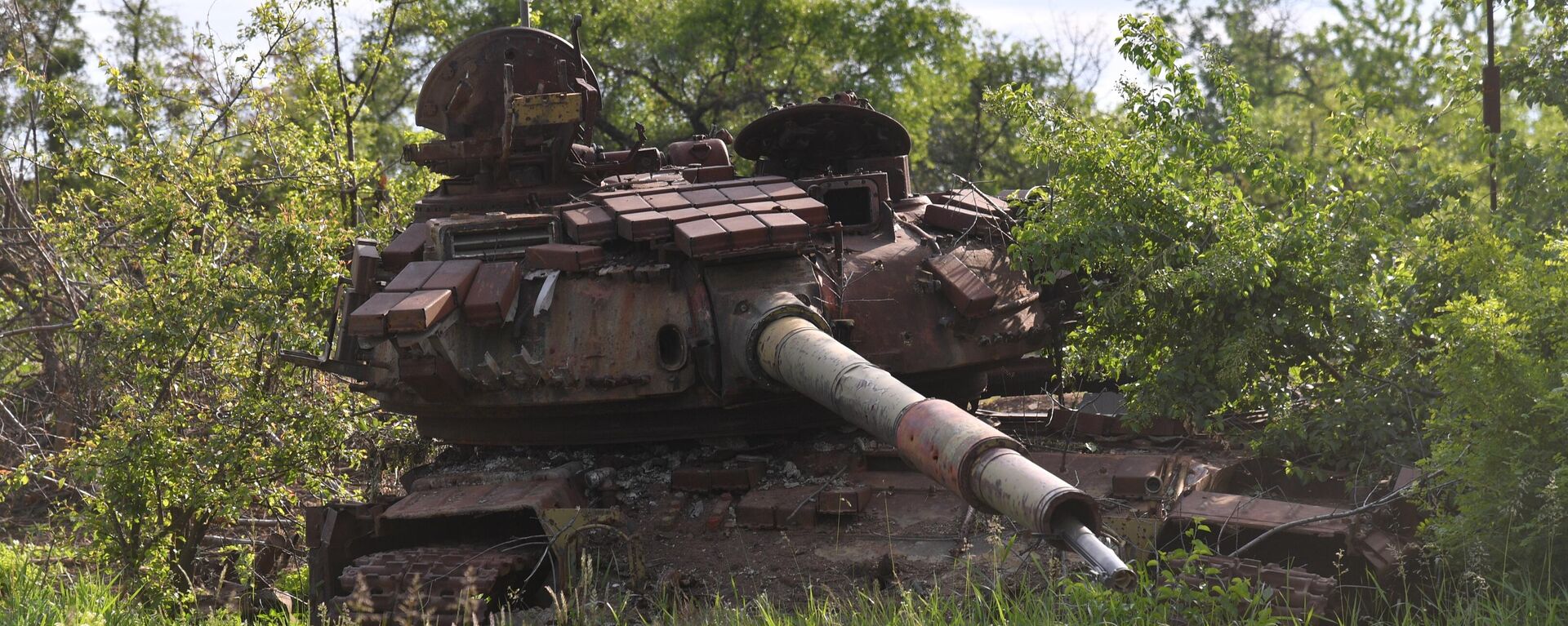
3 October 2023, 13:35 GMT
Sputnik demystifies battle tanks by singling out the fastest ones and understanding the nuances of their speed. This involves comprehensively examining factors and scrutinizing significant contemporary tanks known for their remarkable speed. Through this exploration, we aim to identify the fastest tank and grasp how this trait influences military outcomes.
Overview of Different Tanks and Their Roles in Warfare
Tanks, the backbone of ground-based armored warfare, come in various classes, each tailored for specific combat roles.
Heavy tanks, although less agile, are formidable in defensive positions and breakthrough operations.
Main Battle Tanks (MBTs), known for their versatility and firepower, are cornerstones of armored divisions.
Medium tanks embody a proportional blend of maneuverability and firepower, ideal for exploiting gaps in enemy lines.
Light tanks are rapid-deployment and reconnaissance-oriented ground warfare vehicles that excel in hit-and-run tactics.
Heavy tanks are a category of armored vehicles designed with an emphasis on maximum firepower and robust armor protection. They are characterized by their substantial weight, which can often exceed 60 tons, making them formidable behemoths on the battlefield. The primary purpose of heavy tanks is to engage in head-on confrontations with enemy forces, acting as spearheads in offensive operations and as impervious defensive bulwarks.
These tanks are engineered to withstand heavy enemy fire, making them ideal for breaching fortified positions or leading assaults against heavily defended areas. Due to their immense weight and powerful armaments, heavy tanks are often tasked with breaking through enemy lines, allowing lighter and more mobile units to exploit the breaches and carry out flanking maneuvers.
Their weight provides them with increased protection, but can reduce their mobility and maneuverability. Other characteristics of heavy tanks include:
Heavily sloped and thick armor, especially at the front, designed to withstand direct hits from enemy shells. This frontal armor can range from 100 mm to over 200 mm in thickness, providing exceptional protection against most types of anti-tank weaponry.
Heavy tanks are equipped with powerful main guns, often ranging from 75 mm to 155 mm or larger - capable of firing high-caliber shells with high velocity, making them highly effective against both enemy armor and fortified positions. Additionally, heavy tanks are fitted with secondary weapons, typically machine guns with calibers of 7.62 mm or larger, for engaging infantry and light vehicles.
These battle beasts are powered by formidable engines, with capacities ranging from 500 to 1,800 horsepower. This engine power provides them with enough force to move across various terrains. However, due to their weight, heavy tanks tend to have lower top speeds compared to lighter tanks. They might achieve speeds between 20 to 40 kilometers per hour on roads and significantly lower speeds off-road. Advances in engineering and transmission technology have improved their mobility over time.
They generally have a larger crew compared to other tank types, including the commander, gunner, loader, driver, and sometimes a machine gunner. Heavy tanks are also equipped with advanced communication systems, including radios, intercoms, and sometimes even more sophisticated command and control equipment for coordinating with other units on the battlefield.
Heavy tanks are equipped with fuel tanks that allow them to operate over longer distances, depending on the specific model and engine efficiency.
They can have an operational range of 150 to 500 kilometers. To distribute their weight and improve cross-country performance, heavy tanks often employ advanced suspension systems, such as torsion bars or other innovative designs, to maintain stability on uneven terrain.
Need for Logistical Support
Due to their immense weight, heavy tanks may require specialized transport vehicles or equipment for long-distance deployment or air transport, making them more logistically challenging compared to lighter tanks. These technical specifications collectively define the capabilities and limitations of heavy tanks, highlighting their role as heavily armored, hard-hitting assets on the battlefield.
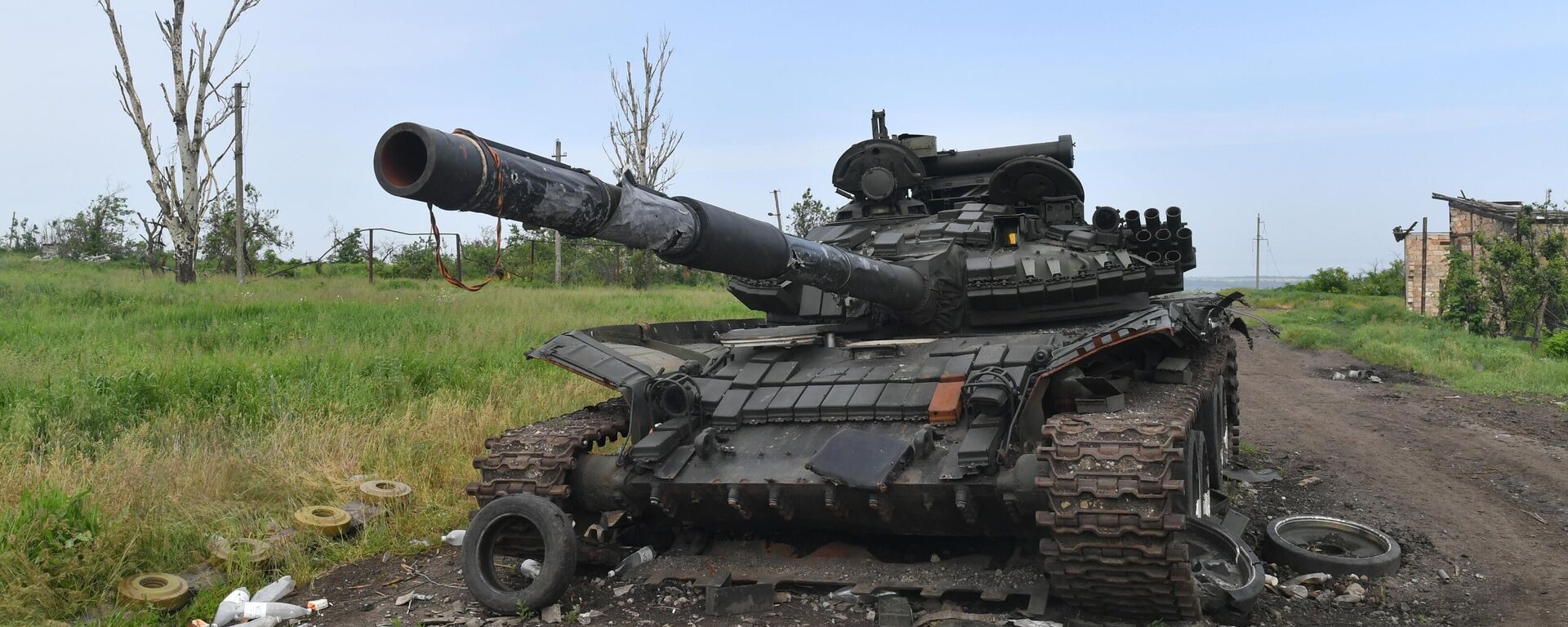
2 October 2023, 18:31 GMT
Evolution of Heavy Tanks in Military History
The inception of heavy tanks in warfare traces back to their early development during the stormy days of World War I. This period was marked by ingenuity and experimentation in armored combat strategies.
As World War I unfolded, the emergence of tanks came in direct response to the problematic issues posed by trench warfare. Efforts by nations like Britain, France, and Germany paved the way for the advent of these mechanized marvels. The early iterations, such as the British Mark series and the French Schneider CA1, bore the distinctive features of pace, armor, and a weaponry mix comprising machine guns and modest-caliber artillery. Their primary mission was to pierce deeply entrenched enemy lines. However, they encountered engineering hitches, like mechanical reliability concerns and constrained speed. Nonetheless, they demonstrated the transformative potential of armored vehicles in breaching impregnable positions.
Interwar Period (1919-1939) During the interwar interlude, a surge of innovation swept through tank design and technology. Engineers were profoundly enthralled by refining mobility, firepower, and armor integrity. It was during this period that the conceptual framework of heavy tanks materialized. Distinguished by their substantial heft, terrific armor cladding, and tough armaments, heavy tanks were envisaged as vanguards of assaults, breakthrough units against enemy lines, and bastions of resilience against concentrated fire.
The crucible of World War II heralded the widespread deployment of heavy tanks, particularly by key players like the Soviet Union, Germany, and, to a lesser extent, the US and United Kingdom. The Soviet Union unveiled heavy tanks like the IS-2 and IS-3, engineered to engage heavily fortified strongholds. Germany, in turn, introduced heavy tanks like the Tiger I and Tiger II (King Tiger), characterized by their heavily fortified armor and the firepower prowess of their 88 mm guns. The Allied forces fielded heavy tanks, with a preference for more balanced designs such as the British Churchill and the American M26 Pershing, which skillfully blended firepower, protection, and mobility. In the Pacific theater, the US adroitly employed tanks like the M4 Sherman, bolstered by additional armor, aptly christened the Jumbo Sherman to surmount heavily entrenched Japanese positions.
Post-World War II Era and Beyond The aftermath of World War II unraveled the constraints of heavy tanks. Evolving anti-tank weaponry and shifts in military doctrines laid the groundwork for the ascendance of main battle tanks (MBTs). These heralded a new era, amalgamating the soundness of heavy tanks with a newfound agility and adaptability. This fundamental transition adjusted the interplay in armored warfare. While heavy tanks have receded amidst historical accounts, their legacy endures in the blueprint of contemporary armored vehicles. Tenets like robust armor plating and formidable main artillery find a seamless integration into the modern armory.
Notable examples of heavy tanks with major technical specification are as follows:
IS-3 Heavy Tank
Attributes | Details |
Origin | Built in late 1944 by Factory No.100 Kirovsky Works, Russia |
Military Service | Formerly used by Czechoslovakia and the Soviet Union. Also served in the North Korean, Egyptian, Georgian, Hungarian, and Ukrainian armed forces. |
Propulsion/Engine | V-2-1S diesel V12 600 hp at 2000 rpm (450 kW) |
Maximum Velocity | 40 km/h |
Dimensions | - Length - 9.85 m
- Width - 3.15 m
- Height - 2.45 m
|
Churchill Mark IV Heavy Tank
Attributes | Details |
Origin | Vauxhall Motors, British Empire |
Military Service | Not in service, but formerly used by the armed forces of Australia, Canada, India, Ireland, Poland, United Kingdom, and Iraq. |
Propulsion/Engine | Bedford 12-cylinder, 4 stroke, water-cooled, horizontally opposed, L-head petrol engine
350 hp (261 kW) at 2,200 rpm |
Maximum Velocity | 24 km/h |
Dimensions | - Length - 7.44 m
- Width - 3.25 m
- Height - 2.49 m
|
Tiger II Heavy Tank
Attributes | Details |
Origin | Henschel und Sohn GmbH, Germany |
Military Service | Germany (1944-1945) |
Propulsion/Engine | Maybach model HL 230 P45 V-12 700-hp petrol engine |
Maximum Velocity | 41.5 km/h |
Dimensions | - Length - 7.38 m
- Width - 3.76 m
- Height - 3.09 m
|
M103 A2 Heavy Tank
Attributes | Details |
Origin | Stellantis North America, officially FCA US, LLC and formerly Chrysler Corporation, USA |
Military Service | US Army (1957-1974) |
Propulsion/Engine | Continental AVDS-1790-2, V12, air-cooled, twin turbocharged diesel - 750 hp (560 kW) |
Maximum Velocity | 37 km/h |
Dimensions | - Length - 11.33 m
- Width - 3.71 m
- Height - 3.20 m
|
Main Battle Tank or Battle Tank
At the forefront of armored warfare, battle tanks (also main battle tanks) embody the zenith of technological prowess. These multirole armored vehicles are conscientiously built to thrive in diverse battlefield scenarios, deftly striking a balance between offensive striking power, agility, and protection. This equilibrium renders them highly proficient in engaging enemy armor and infantry, underscoring their indispensability in modern armored warfare.
The Organization for Security and Cooperation in Europe (OSCE), defines a “battle tank” as a self-propelled armored fighting vehicle, capable of heavy firepower, primarily with a high muzzle velocity direct fire main gun necessary to engage armored and other targets, with high cross-country mobility, with a high level of self-protection, and which is not designed and equipped primarily to transport combat troops. Such armored vehicles serve as the principal weapon system of ground-force tank and other armored formations.
Battle tanks are tracked armored fighting vehicles which weigh at least 16.5 metric tons unladen and which are armed with a 360-degree traverse gun of at least 75-millimeter caliber. In addition, any wheeled armored fighting vehicles entering into service which meet all the other criteria stated above are also deemed battle tanks.
These military machines represent the height of armored warfare, blending offensive power, agility, and defense for versatile performance on the battlefield. They excel in engaging enemy armor and infantry, making them crucial in modern warfare. The 1960s and 1970s marked a significant shift as battle tanks took precedence, leading to the decline of other tank types and specialized armored vehicles.
During the 1960s, the military sphere witnessed a shift driven by the relentless pursuit of technological superiority in warfare. As advancements in anti-tank ammunition surged, so did the demand for avant-garde armor solutions. One pivotal milestone emerged in the form of the Soviet T-64 tank, a precursor of innovation that introduced composite armor into the global military lexicon. This novel development encompassed a sophisticated blend of reinforced glass, steel, and textolite, ushering in a new era of protection against formidable adversaries in the ever-evolving theater of war, including high-explosive anti-tank rounds and armor-piercing shells.
Conceived at the esteemed Royal Ordnance Factories, the British Chobham armor represented a watershed moment in defensive technology by ingeniously combining ceramics with diverse other materials, effectively neutralizing the destructive potential of high-explosive anti-tank munitions.
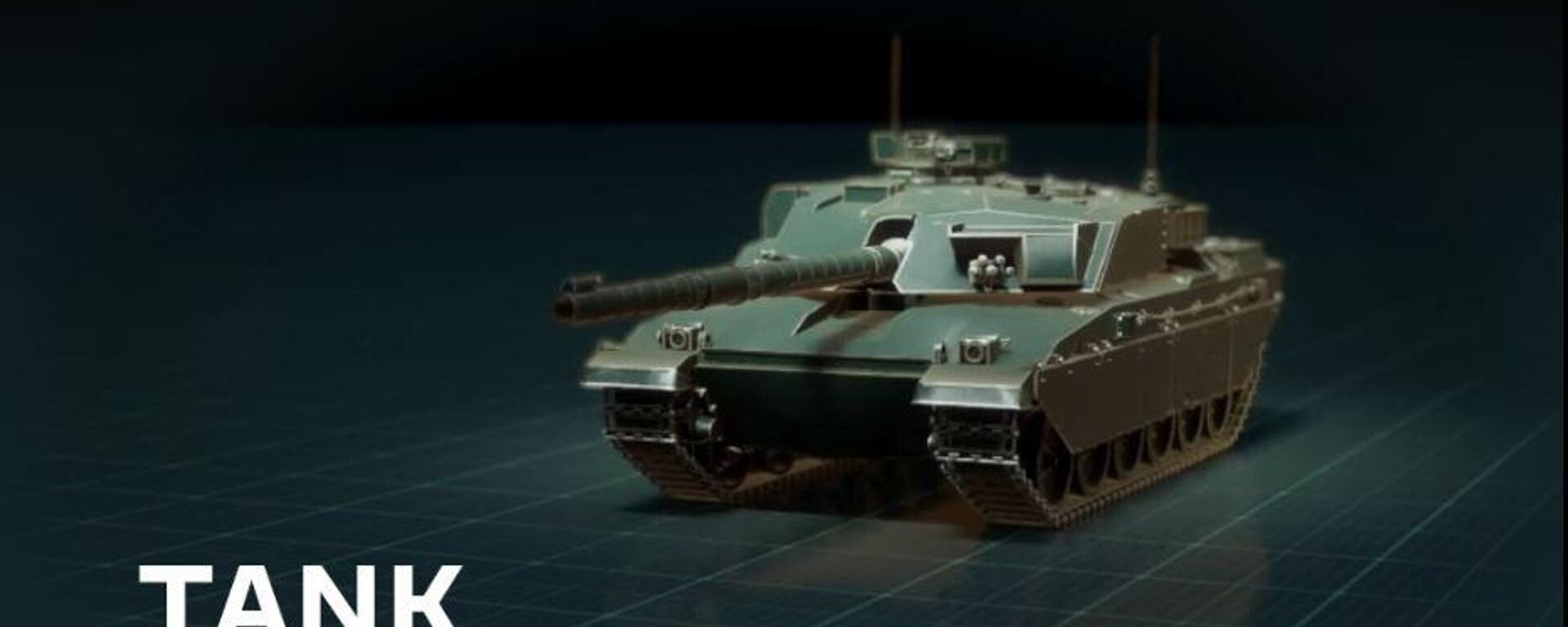
25 September 2023, 16:26 GMT
The advent of military helicopters posed a fresh conundrum in the dynamic landscape of combat operations. Before their widespread deployment, armored vehicles were meticulously crafted with a primary focus on frontal defense. However, the advent of military helicopters necessitated a turning point in tank design philosophy. This entailed the installation of shields encompassing all sides, offering comprehensive protection against potential threats. Additionally, this strategic adjustment sought to shield occupants from possible radiation exposure, further underscoring the need for a holistic defensive overhaul. Initially, main battle tanks relied on formidable steel armor to mitigate a spectrum of risks. Nevertheless, as the challenges escalated in sophistication, it became evident that a fundamental transformation in defense mechanisms was imperative to counter these evolving risks effectively.
Warfare technology advanced in the 1980s with the advent of explosive reactive armor (ERA), a novel invention spearheaded by Israel. This transformative system is a formidable bulwark against modern anti-tank weaponry and armor-piercing shells, heralding a new era in battle tank security. The versatility of ERA lies in its swift relevance to tanks, instantly bolstering their resilience on the battlefield.
However, activating ERA blocks introduces a crucial consideration: potential risks to nearby ground troops. Despite this concern, ERA has firmly entrenched itself as a pivotal feature in the arsenal of many Russian battle tanks, particularly in its Kontakt-5 iteration. This advancement has proven instrumental in effectively countering high-explosive anti-tank (HEAT) rounds and kinetic projectiles, underscoring its enduring relevance in modern warfare.
Active protection systems (APS) have also emerged as a critical invention, initially conceived by the Soviets. These systems are engineered to thwart threats well before they reach their intended target – the tank. Noteworthy iterations like the Arena and Shtora systems have garnered widespread recognition for their efficacy in safeguarding armored assets. Discussions within military circles underscore the formidable capabilities of Russia's latest marvel, the T-14 Armata tank, spotlighting its Afghanit Active Protection System, seamlessly integrated with an advanced AESA radar. This integration empowers the T-14 Armata to intercept a broad spectrum of airborne threats, from missiles to potential aerial adversaries.
The United States has embraced analogous technologies, exemplified by including the Missile Countermeasure Device (MCD) within the Tank Urban Survival Kit (TUSK) deployed alongside the M1 Abrams tanks during military operations in Iraq.
At the core of an MBT's offensive might lies its main gun, ingeniously integrated into the turret. This strategic placement allows for swift and precise targeting, a pivotal aspect in the heat of battle. The loading and firing mechanisms are meticulously designed, ensuring seamless operation even in the most demanding combat situations.
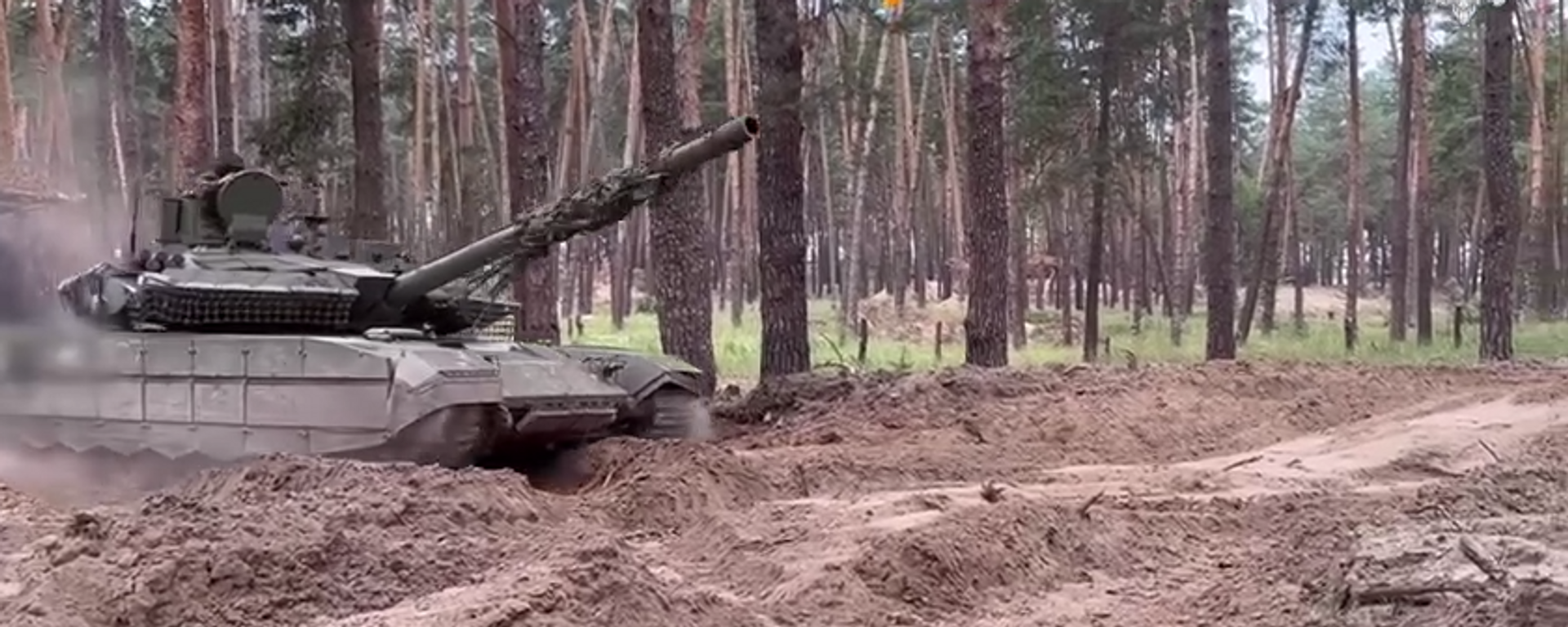
14 September 2023, 15:42 GMT
The contemporary MBT is an engineering marvel, boasting advanced fire-control systems that unprecedentedly elevate its combat prowess. This sophisticated suite includes cutting-edge range finders, automated controls, and stabilizers. These components guarantee pinpoint accuracy, even amidst tank movement or external vibrations.
The integration of such advanced fire-control systems not only fortifies the tank's offensive capabilities, but also empowers its crew. The tank's gunnery team gains unprecedented control and precision when engaging targets, ensuring every shot counts. This technological leap has redefined the dynamics of armored warfare, providing crews with a distinct advantage on the battlefield.
The dual-purpose main gun is the linchpin of a battle tank’s adaptability. This capability means that a single tank can swiftly transition from engaging heavily armored adversaries to addressing infantry or enemy vehicles. Such versatility ensures that MBTs remain a formidable force across an array of combat scenarios.
Modern battle tanks are typically part of armored units, often accompanied by infantry in specialized fighting vehicles. Surveillance resources and ground-attack aircraft also support them. Like their predecessors, these tanks use continuous tracks for mobility, allowing them to navigate rugged terrain like sand and mud. This track system also enables them to overcome various obstacles.
Tanks are designed to be watertight, allowing them to submerge in shallow waters with a snorkel. While tracks provide stability, tanks are generally slower than wheeled vehicles, with a top speed of around 65 kilometers per hour (40 miles per hour). The German Leopard 2 stands at 72 km/h (45 mph). Tanks weigh between 40 to 70 tons, which limits their speed. They are equipped with powerful engines, boasting 1,200 to 1,500 horsepower (890 to 1,120 kilowatts), and have a travel range of about 500 km (310 miles).
Within the robust frame of modern battle tanks lies a carefully designed structure dedicated to storage inside and outside the vehicle. These compartments serve distinct purposes, with the interior primarily allocated for ammunition and the external space reserved for additional fuel reserves and personal crew equipment. This meticulous allocation of distance ensures that tanks are equipped for extended engagements and versatile combat scenarios.
Examples of main battle tanks with key technical specifications include:
T-90 Main Battle Tank
Attributes | Details |
Origin | Uralvagonzavod, Russia |
Military Service | Russian, Indian, Vietnamese, Algerian, Cypriot, Libyan, Venezuelan, Saudi, Iraqi, Peruvian armed forces, etc. |
Propulsion/Engine | Liquid-cooled V-84MS engine, boasting 618 kW (840 hp) output from a four-stroke V-12 piston assembly. Runs on T-2 or TS-1 kerosene, A-72 benzene, and even diesel fuel. |
Maximum Velocity | 60 km/h |
Dimensions | - Length - 9.53 m
- Width - 2.22 m
- Height - 2.4 m
|
Observation | The gunner’s 1A43 day Fire Control System (FCS) is outfitted with a 1G46 day sight / rangefinder with a missile guidance channel, a 2E42-4 armament stabilizer, a 1V528 ballistic computer, and a DVE-BS wind gauge. In the commander’s PNK 4S sight, there is a TKN-4S (Agat-S) day/night sight, with identification ranges of 800 meters (day) and 700 meters (night). The driver has TVN-5 infrared-enabled nocturnal optics. |
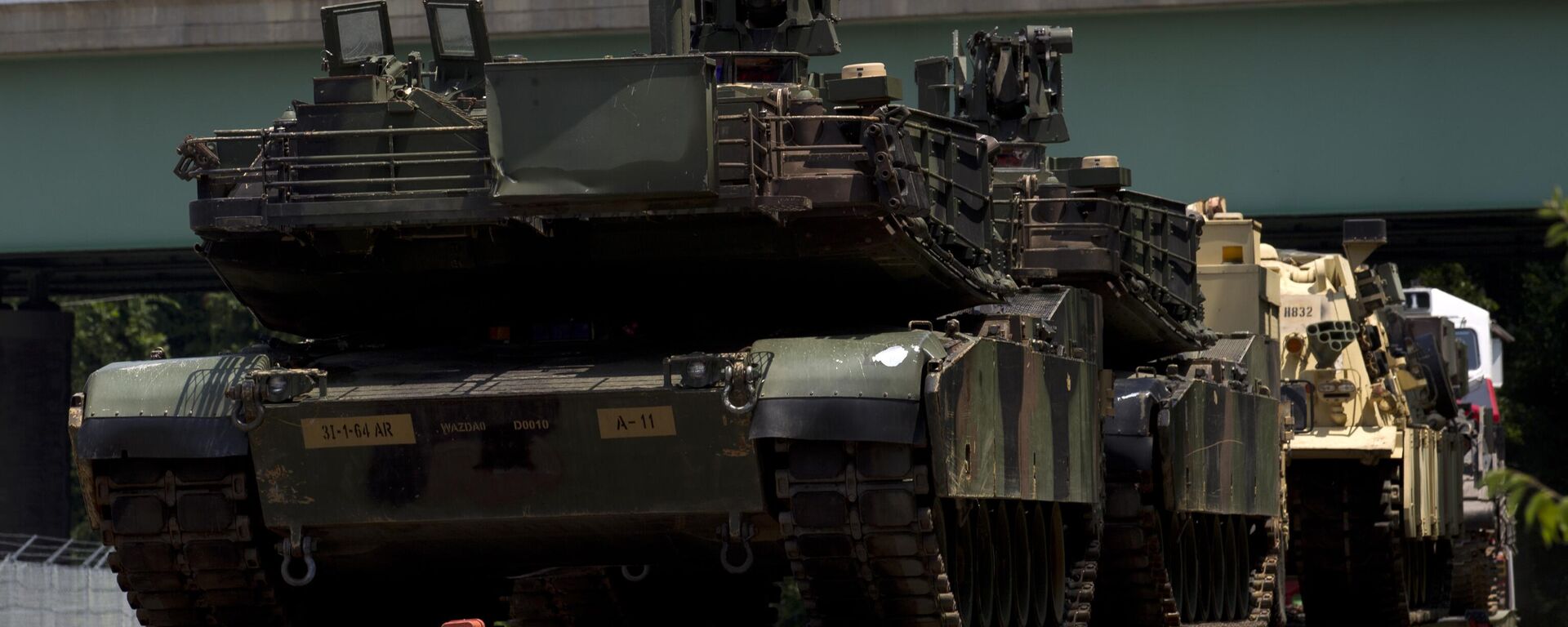
27 September 2023, 19:14 GMT
M1A2 SEPv3 Abrams Main Battle Tank
Attributes | Details |
Origin | General Dynamics Land Systems, USA |
Military Service | US Army |
Propulsion/Engine | Honeywell AGT1500 gas turbine engine in the M1A2 SEPv3 variant |
Maximum Velocity | 67.59 km/h |
Dimensions | - Length - 9.7 m
- Width - 3.7 m
- Height - 2.4 m
|
Observation | Fitted with an advanced forward-looking infrared (IFLIR) system, the tank excels in target detection. IFLIR technology leverages both long and mid-wave infrared methods to enhance target acquisition, identification, and engagement |
ZTZ99 (Type 99) Main Battle Tank
Attributes | Details |
Origin | People’s Liberation Army (PLA) by China Northern Industries Corporation (CNGC) or Norinco |
Military Service | People’s Liberation Army (PLA) |
Propulsion/Engine | Driven by a 1,500 horsepower diesel engine, based on German MB871ka501 diesel technology |
Maximum Velocity | 80 km/h |
Dimensions | - Length - 7.6 m
- Width - 3.7 m
- Height - 2.35 m
|
Observation | This system is equipped with a laser warning receiver (LWR) in tandem with an active laser self-defense weapon (LSDW) arranged in a box-like structure. A high-energy laser can be deployed to target the adversary's weapon operator and optical components. The potent LSDW is capable of interfering with the enemy's missile laser and infrared guidance signals |
Leopard 2 Main Battle Tank
Attributes | Details |
Origin | Krauss-Maffei Wegmann (KMW), Rheinmetall, Germany |
Military Service | Armed forces of Austria, Canada, Chile, Denmark, Finland, Germany, Greece, the Netherlands, Norway, Poland, Portugal, Singapore, Switzerland, Sweden, Spain, and Turkiye |
Propulsion/Engine | Propelled by an MTU MB 873 diesel engine, generating 1,100 kilowatts (1,500 shaft hp). It's worth mentioning that trials have explored the use of the MTU MT883 engine, which boasts an impressive 1,210 kilowatts (1,650 shaft hp) |
Maximum Velocity | 70 km/h |
Dimensions | - Length - about 10.97 m
- Width - 3.77 – 4.00 m
- Height - 2.64 m
|
Observation | Within the gunner's station, you'll find a Rheinmetall Defense Electronics EMES 15 dual magnification stabilized primary sight. The direct view is enriched with an integrated laser rangefinder (a CE628 laser - a Neodymium Yttrium Aluminum Garnet, [Nd:YAG] solid-state laser) and a Zeiss Optronic thermal sight, model WBG-X. These components are both interconnected with the tank’s fire control computer |
Challenger 2 Main Battle Tank
Attributes | Details |
Origin | BAE Systems Land Systems, United Kingdom |
Military Service | British Army, Royal Army of Oman, Ukraine, Poland |
Propulsion/Engine | 12-cylinder, 1,200 hp Perkins Caterpillar CV12 diesel engine |
Maximum Velocity | 59 km/h |
Dimensions | - Length - 8.3 m
- Width - 3.5 m
- Height - 2.5 m
|
Observation | The commander utilizes a panoramic VS 580-10 gyro-stabilized sight developed by SAGEM (previously SFIM Industries). In contrast, the gunner employs a Thales Optronics stabilized Gunner’s Primary Sight, equipped with a visual channel, a 4Hz laser rangefinder, and a display. This rangefinder is effective within a range of 200 meters to 10 kilometers |
These battle beasts have played a formative influence on the development of armored conflict since their inception. Emerging in the interwar period, these versatile vehicles bridged the gap between the heavily armored but slower heavy tanks and the lighter, more maneuverable light tanks.
As military strategies developed, medium tanks became instrumental in a variety of combat scenarios. During World War II, they demonstrated their adaptability on the battlefield. Medium tanks were employed for a range of missions, from infantry support and flanking maneuvers to breakthrough operations. Their balance of mobility, firepower, and armor protection made them indispensable assets for armored divisions in numerous conflicts.
In the post-World War II era, medium tanks continued to be a mainstay of armored warfare, finding application in various theaters of conflict around the globe. Their enduring significance in military operations is a testament to their adaptable nature and effectiveness in diverse combat scenarios.
Definition and Primary Purpose
Medium tanks are a class of armored vehicles designed to strike a balance between the firepower of heavy tanks and the mobility of light tanks. They typically weigh 25 to 45 tons, offering speed, protection, and armament.
The primary purpose of medium tanks is to serve as multirole combat platforms. They are well-suited for various missions, including breakthrough operations, flanking maneuvers, infantry support, and surveillance. Their versatility allows commanders to deploy them in multiple roles on the battlefield, making them a vital component of armored forces.
Medium tanks are characterized by their ability to navigate diverse terrains, engage enemy armor and infantry effectively, and provide a versatile and adaptable response to changing battlefield conditions. Their design balances the heavier, more heavily armored tanks and the lighter, more agile reconnaissance vehicles.
A few examples of medium tanks and their specifications are detailed as follows:
T-34-85 Medium Tank
Attributes | Details |
Origin | Soviet Union |
Military Service | Formerly in service with the armed forces of the Soviet Union, North Korean People's Army, Angola, Yugoslav People's Army, etc. Currently in service with the armies of Mali, Republic of the Congo, Guinea, Guinea-Bissau, Namibia, North Korea, Yemen, and Vietnam |
Propulsion/Engine | Model V-2-34 38.8 L V12 Diesel engine 500 hp (370 kW) |
Maximum Velocity | 53km/h |
Dimensions | - Length - 6.68 m
- Width - 3.00 m
- Height - 2.46 m
|
Panzer IV Medium Tank
Attributes | Details |
Origin | Friedrich Krupp AG (1968-1991), Steyr-Daimler-Puch AG (Defunct), Germany |
Military Service | Was in service with the armies of Germany, Romania, Turkiye, Hungary, Italy, Bulgaria, Finland, Spain, Croatia, Syria, etc. |
Propulsion/Engine | Maybach HL120 TRM 12-cylinder petrol engine 300 PS (296 hp, 220 kW) |
Maximum Velocity | 38 – 42 km/h |
Dimensions | - Length - 5.92 m
- Width - 2.88 m
- Height - 2.68 m
|
M4 Sherman Medium Tank
Attributes | Details |
Origin | Lima Locomotive Works, Pressed Steel Cars Co., Pacific Car & Foundry, Baldwin Locomotive Works, American Locomotive Co., Pullman Car, Chrysler’s Detroit Tank Arsenal, Pullman Standard Car Manufacturing Co., Federal Welder, Fisher and Grand Blanc in Michigan, USA |
Military Service | 1942–2018 (Paraguay)
1942–1957 (United States) |
Propulsion/Engine | Continental R975 9-cyl. air-cooled gasoline, 400 hp (298 kW) |
Maximum Velocity | 48 km/h |
Dimensions | - Length - 5.84 m
- Width - 2.62 m
- Height - 2.74 m
|
Light tanks have a storied history in the annals of armored warfare. Originating in the interwar period, they were developed to complement infantry and reconnaissance units, providing them with armored support and rapid mobility. These tanks played a vital role in various conflicts, particularly during World War II. In the early stages of World War II, light tanks were deployed for reconnaissance missions and engaging lightly armored enemy vehicles. However, as the war progressed and the battlefield dynamics evolved, their limitations in terms of firepower and armor became apparent. They were gradually replaced or supplemented by more versatile medium and main battle tanks. Post-World War II, light tanks saw continued use in specialized roles like reconnaissance and airborne operations. Technological advances, including armor and armament improvements, allowed them to remain relevant in modern armored forces, albeit in more niche roles.
Depiction and Primary Purpose
Light tanks are armored vehicles characterized by their relatively low weight, agility, and speed. They are designed for surveillance, quick maneuvering, and support roles on the battlefield. Light tanks typically weigh between 5 and 20 tons, making them more lightweight and maneuverable than their heavier counterparts. The primary purpose of light tanks is to provide reconnaissance and security for larger military units. Their speed and agility make them adept at sidestepping tactics, scouting enemy positions, and engaging lightly armored targets. Additionally, they are well-suited for operations in terrain where heavier tanks might face difficulties. Light tanks are often used in scenarios where speed and mobility are paramount. They are also employed when a rapid response is needed, such as in reconnaissance missions or airborne operations. While they may lack the firepower and armor of heavier tanks, their versatility and speed allow them to perform critical roles on the battleground.
World War II-Era Light Tanks
T-37A Light Tank
Attributes | Details |
Origin | NIIDAR, Russia |
Military Service | Formerly used by the Soviet Army |
Propulsion/Engine | GAZ-AA 40 hp (30 kW) |
Maximum Velocity | 35 km/h |
Dimensions | - Length - 3.75 m
- Width - 2.10 m
- Height - 1.82 m
|
Type 95 Ha-Go Light Tank
Attributes | Details |
Origin | Mitsubishi Heavy Industries, Niigata Tekko Sho, Dowa Jido Sho, Sagamu Arsenal, Ikegai Automobile Manufacturing Co, Ihesil Automobile, etc., Japan |
Military Service | Formerly served in the Imperial Japanese Army and Royal Thai Army |
Propulsion/Engine | 120 hp Mitsubishi 6-cylinder diesel engine |
Maximum Velocity | 40 – 45 km/h |
Dimensions | - Length - 3.75 m
- Width - 2.10 m
- Height - 1.82 m
|
TULPAR Light Tank
Attributes | Details |
Origin | Otokar Otomotiv ve Savunma Sanayi, Turkiye |
Military Service | Turkish Army |
Propulsion/Engine | 16l, eight-cylinder, water-cooled V8 turbo charged diesel engine with a rated power output of 720hp (530kW) |
Maximum Velocity | 70 km/h |
Dimensions | - Length - 7.23 m
- Width - 3.45 m
- Height - 2.76 m
|
Sabrah Light Tank
Attributes | Details |
Origin | Elbit Systems, Israel |
Military Service | Philippine Army |
Propulsion/Engine | 8-cylinder Cummins Diesel ISLe T450 HPCR engine with automatic transmission, and cooling system |
Maximum Velocity | 72 km/h |
Dimensions | - Length - 7.6 m
- Width - 3.4 m
- Height - 3.67 m
|
Factors Affecting Tank Speed
The design of a tank necessitates a delicate equilibrium between armor protection and speed. Striking this balance is crucial for creating a highly effective combat platform. A well-armored tank is more resilient to enemy fire, enhancing its survivability on the battlefield. However, an excessive focus on armor can result in a tank becoming overly heavy, potentially compromising its speed and maneuverability. Engineers and designers must judiciously allocate resources to achieve an optimal blend of protection and mobility, tailoring each tank to its intended combat role.
In contemporary armored warfare, advances in materials and engineering have facilitated the development of composite armor and other weight-saving technologies. These innovations allow modern tanks to achieve a commendable balance between robust armor protection and the agility required for swift and effective maneuvering on the battlefield. This harmonization of factors is a testament to the continuous evolution of tank design and engineering.
Engine Power: A tank's engine power is a critical determinant of its speed capabilities. A robust engine generates the necessary force to propel the tank's considerable weight across various terrains. The more powerful the engine, the greater the potential for higher speeds. This is especially crucial in dynamic battlefield scenarios where rapid maneuverability can be decisive. Tanks equipped with high-powered engines can swiftly respond to changing tactical situations, enabling them to seize advantages or evade threats with agility.
Weight and Armor: The weight of a tank plays a pivotal role in determining its speed capabilities. Heavier tanks, characterized by extensive armor and weaponry, tend to be slower due to the greater mass they must propel. The additional weight necessitates more powerful engines to achieve speeds comparable to lighter counterparts. Furthermore, heavier tanks may face challenges when navigating challenging terrains, as the increased weight can strain suspension systems and reduce overall maneuverability.
In recent times, several nations have fielded a new generation of fast tanks, incorporating advanced technologies and designs to enhance their speed and maneuverability on the modern battlefield. Here are 10 examples of contemporary fast tanks, along with their origins, engine horsepower, and maximum speeds:
Top 10 Fastest Tanks by Type and Speed
Tanks | Information |
T-14 Armata | - Origin: Ural Design Bureau of Transport Machine-Building, Uralvagonzavod (UVZ), Russia
- Type: Main Battle Tank
- Engine Horsepower: A-85-3A turbocharged diesel engine - 1,200 HP
- Maximum Speed: 90 km/h
|
Type 99 (ZTZ-99) | - Origin: China Northern Industries Corporation (CNGC or Norinco), China
- Type: Main Battle Tank
- Engine Horsepower: German MB871ka501 diesel technology - 1,500 HP
- Maximum Speed: 80 km/h
|
Leopard 2A7+ | - Origin: Krauss-Maffei Wegmann (KMW), Germany
- Type: Main Battle Tank
- Engine Horsepower: MTU MB 873 diesel engine - 1,500 HP
- Maximum Speed: 72 km/h
|
T-84 Oplot-M | - Origin: Kharkov Morozov Machine Building Design Bureau (KMDB), Ukraine
- Type: Main Battle Tank
- Engine Horsepower: 6ТD-2 multifuel, six-cylinder, liquid cooled diesel engine - 1,500 HP
- Maximum Speed: 70 km/h
|
The Altay | - Origin: Milli Tank Uretim Projesi ALTAY (MITUP ALTAY) programme, Turkiye
- Type: Main Battle Tank
- Engine Horsepower: MTU Friedrichshafen Diesel engines - 1,500 HP
- Maximum Speed: 70 km/h
|
K2 Black Panther | - Origin: Hyundai Motor Group, South Korea
- Type: Main Battle Tank
- Engine Horsepower: Tognum-made MT 833 diesel engine - 1,500 HP
- Maximum Speed: 70 km/h
|
AMX-56 Leclerc | - Origin: Nexter Systems (previously known as Giat Industries), France
- Type: Main Battle Tank
- Engine Horsepower: SACM V8X-1500 Hyperbar diesel engine - 1,500 HP
- Maximum Speed: 70 km/h
|
VT4 (MBT-3000) | - Origin: China North Industries Corporation (Norinco), China
- Type: Main Battle Tank
- Engine Horsepower: Turbocharged diesel engine - 1,200 HP
- Maximum Speed: 70 km/h
|
Type 10 (TK-X) | - Origin: Mitsubishi Heavy Industries, Japan
- Type: Main Battle Tank
- Engine Horsepower: Water-cooled, four-cycle, eight-cylinder diesel engines - 1,200 HP
- Maximum Speed: 70 km/h
|
Al-Zarrar | - Origin: Heavy Industries Taxila (HIT), Pakistan
- Type: Main Battle Tank
- Engine Horsepower: liquid-cooled, 12-cylinder diesel engine - 730 HP
- Maximum Speed: 65 km/h
|
Gazing Into Future of Tanks in Modern Warfare
Looking ahead, the trajectory of tank technology promises even more significant advancements in speed capabilities. Engineers and military strategists are actively exploring avenues to enhance tank agility, making them more responsive to the dynamic nature of modern warfare. One key area of focus is the development of advanced propulsion systems. Emerging technologies, such as electric drivetrains and hydrogen fuel cells, hold the potential to revolutionize tank mobility. These innovations promise higher speeds and reduce the logistical burden associated with traditional fossil-fuel-powered engines.
Furthermore, breakthroughs in materials science and manufacturing techniques enable the construction of lighter yet stronger tank hulls. This leads to improved power-to-weight ratios, allowing tanks to achieve higher speeds without sacrificing durability.
Additionally, advancements in suspension systems and track design contribute to smoother rides at increased velocities, enhancing overall maneuverability on various terrains. Beyond hardware, integrating artificial intelligence and autonomous systems is poised to redefine the concept of tank speed. AI-driven algorithms can optimize routes, adjust speed based on real-time data, and even facilitate coordinated movements between multiple tanks, creating a synchronized and highly efficient force.
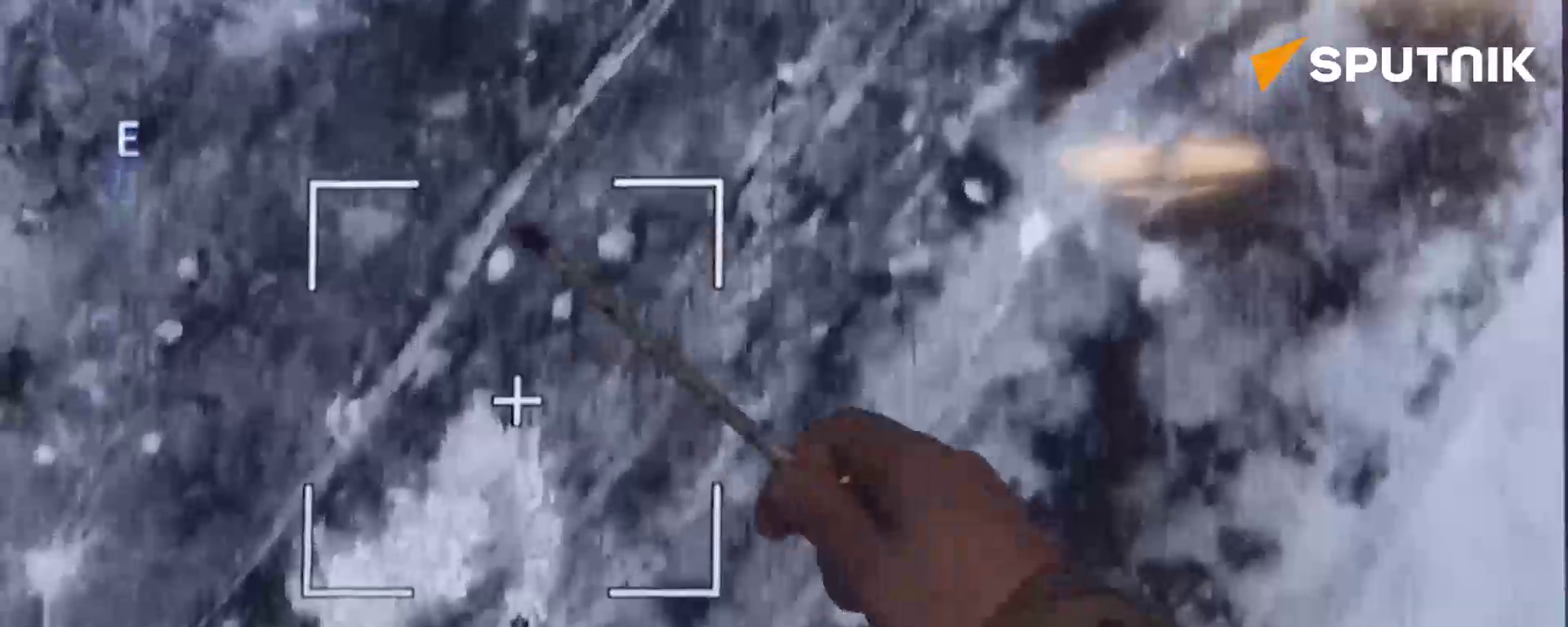
25 September 2023, 13:30 GMT
Moreover, incorporating advanced sensors and communication systems will provide tanks with enhanced situational awareness, enabling them to navigate complex environments at high speeds with greater precision.
Therefore, the future of tank speed in warfare is marked by a convergence of innovative technologies that promise to elevate the capabilities of armored forces to unprecedented levels. These advancements not only enhance tactical advantages, but also reshape the very nature of armored warfare, ensuring that speed remains a paramount factor in determining success on the modern battlefield.
